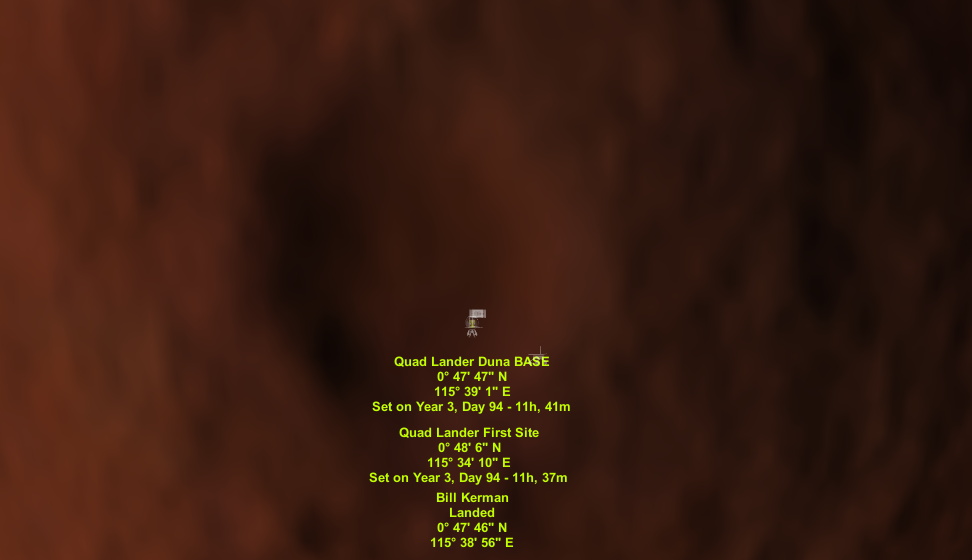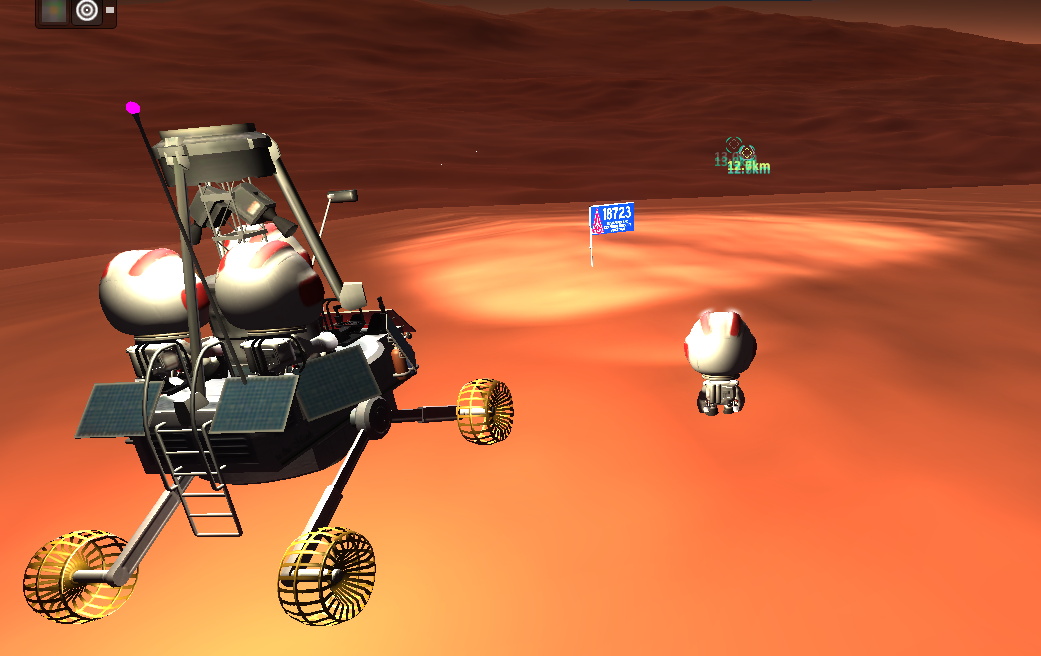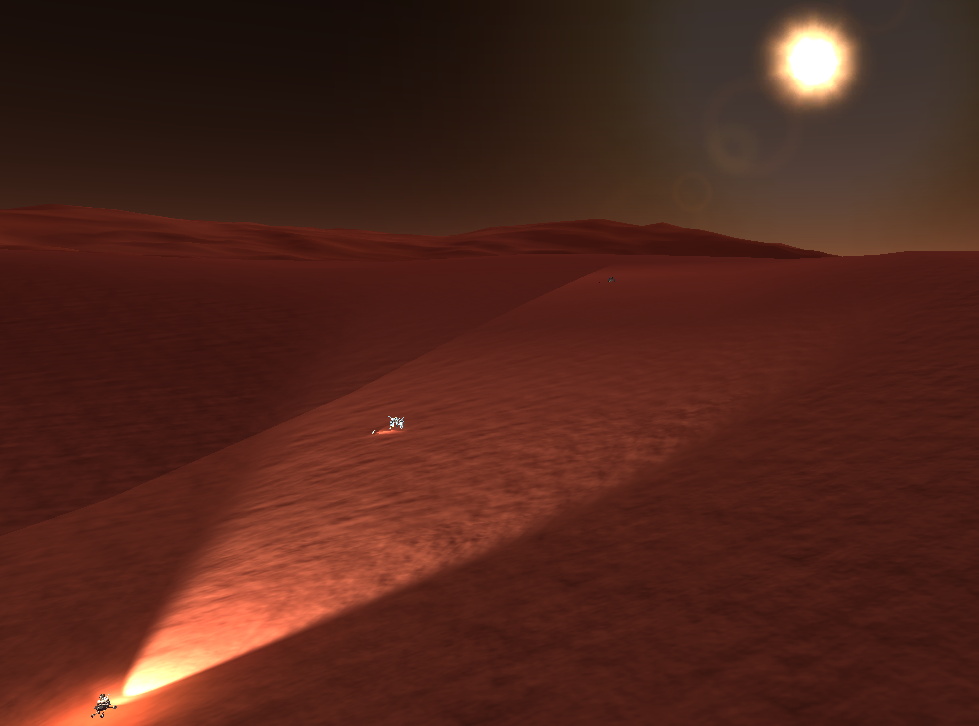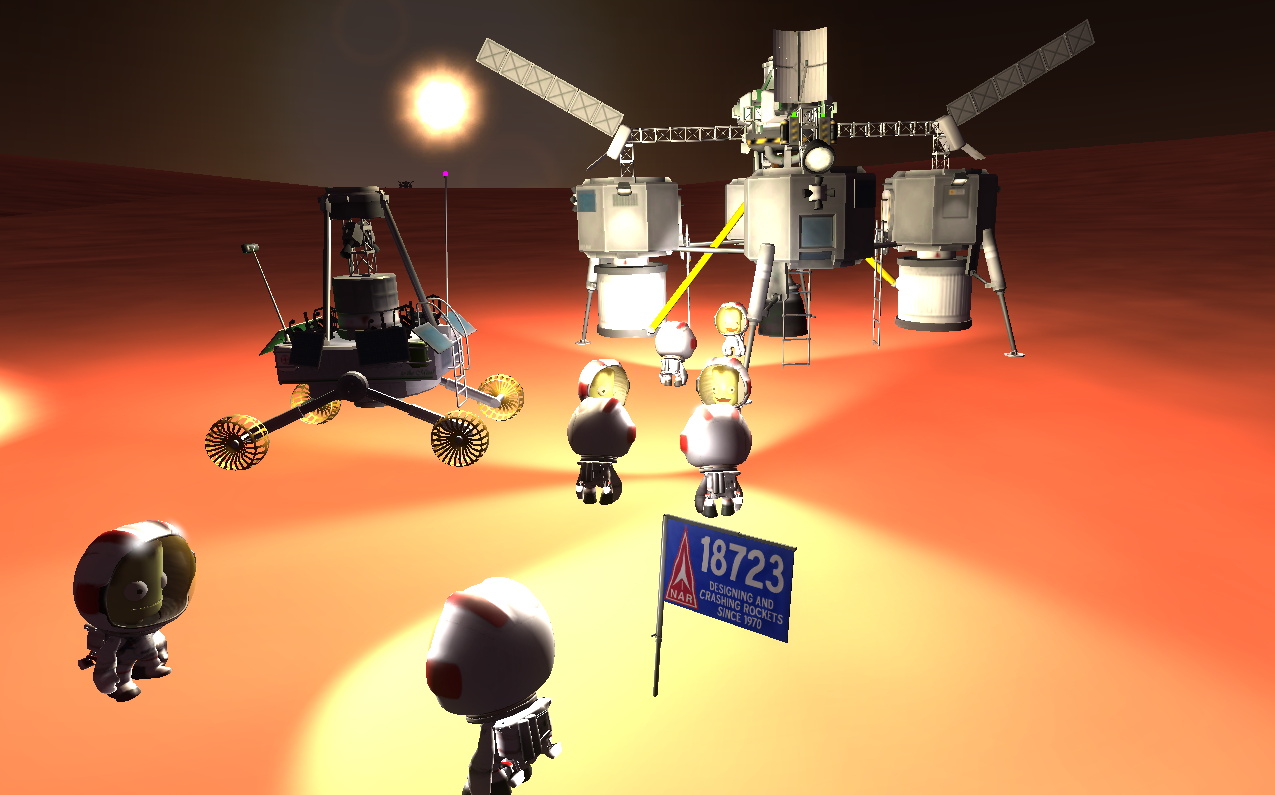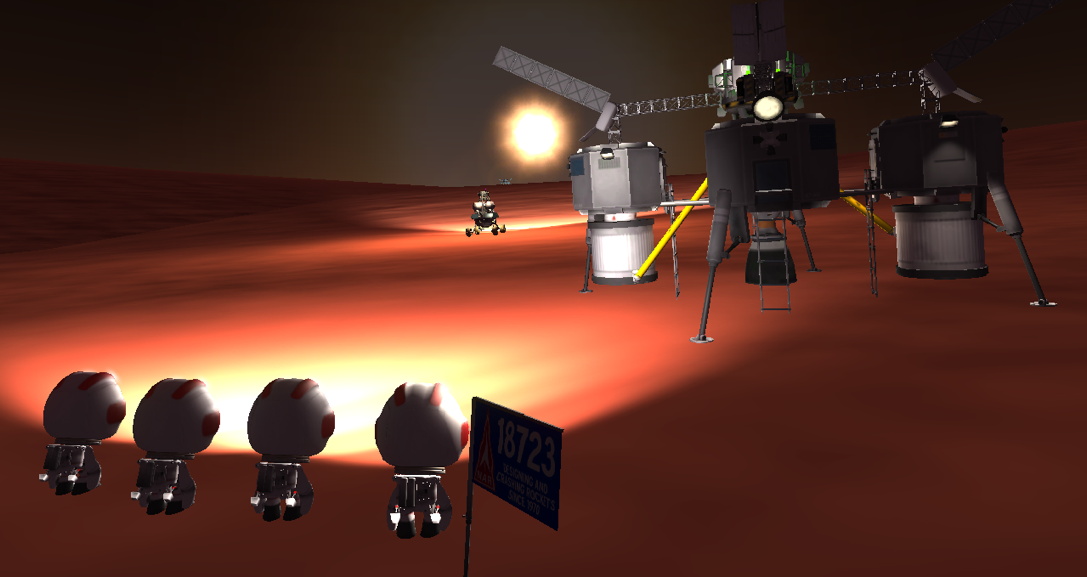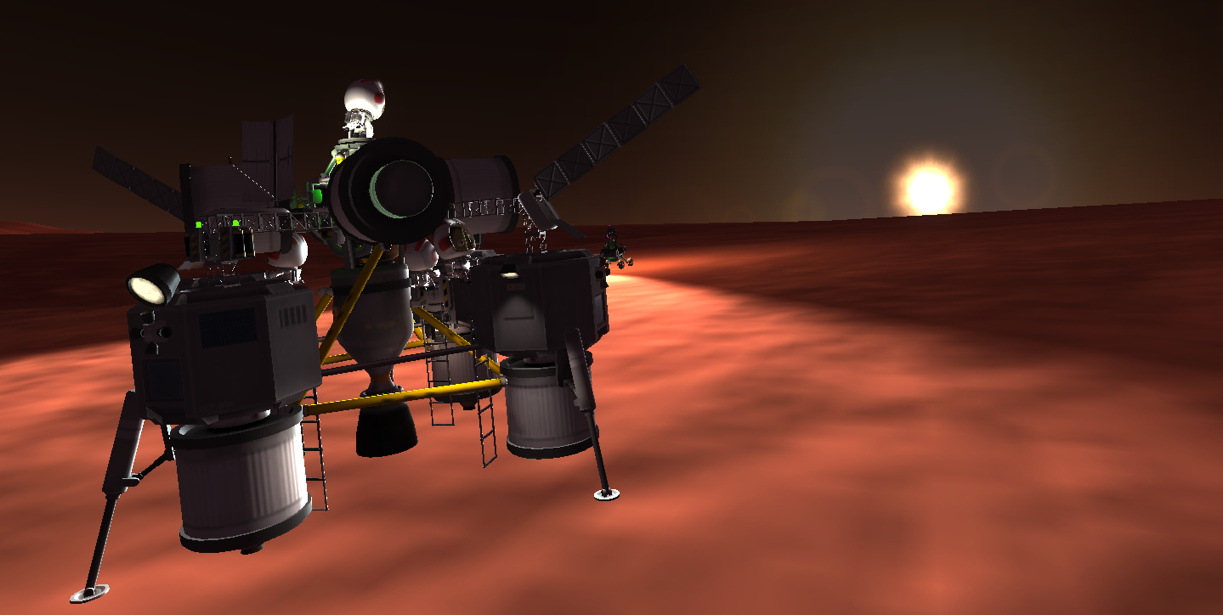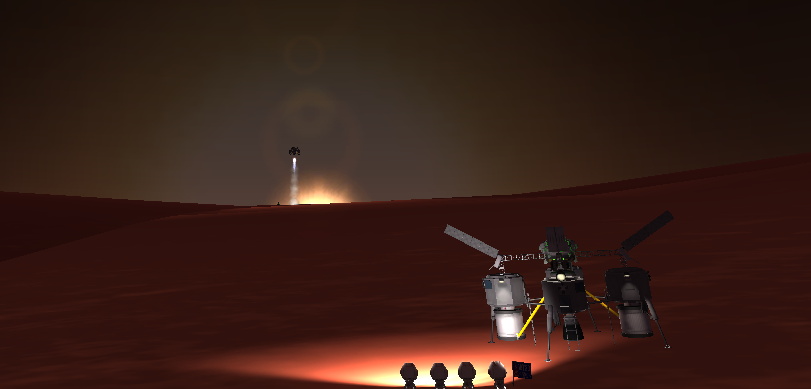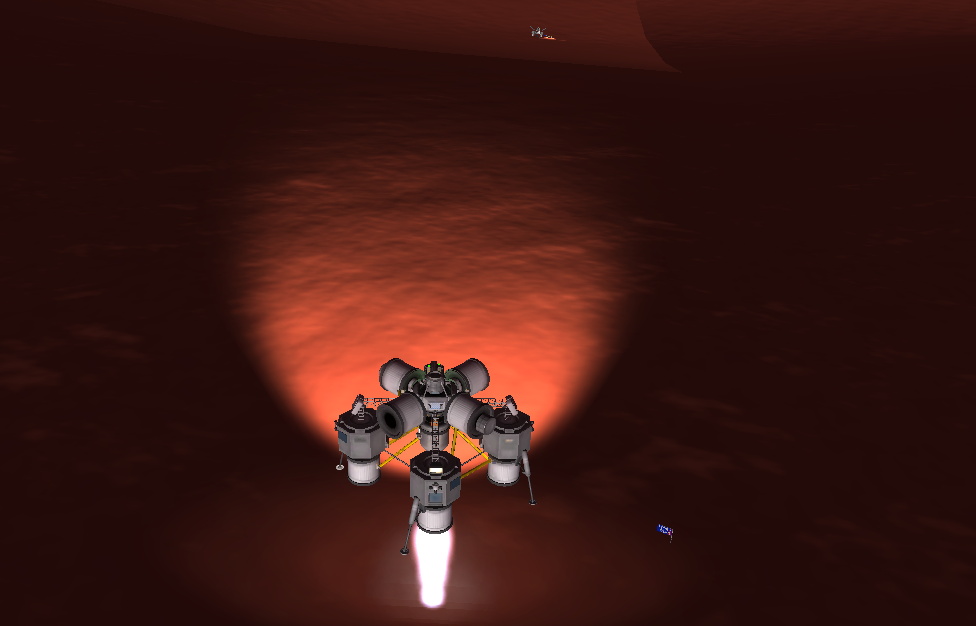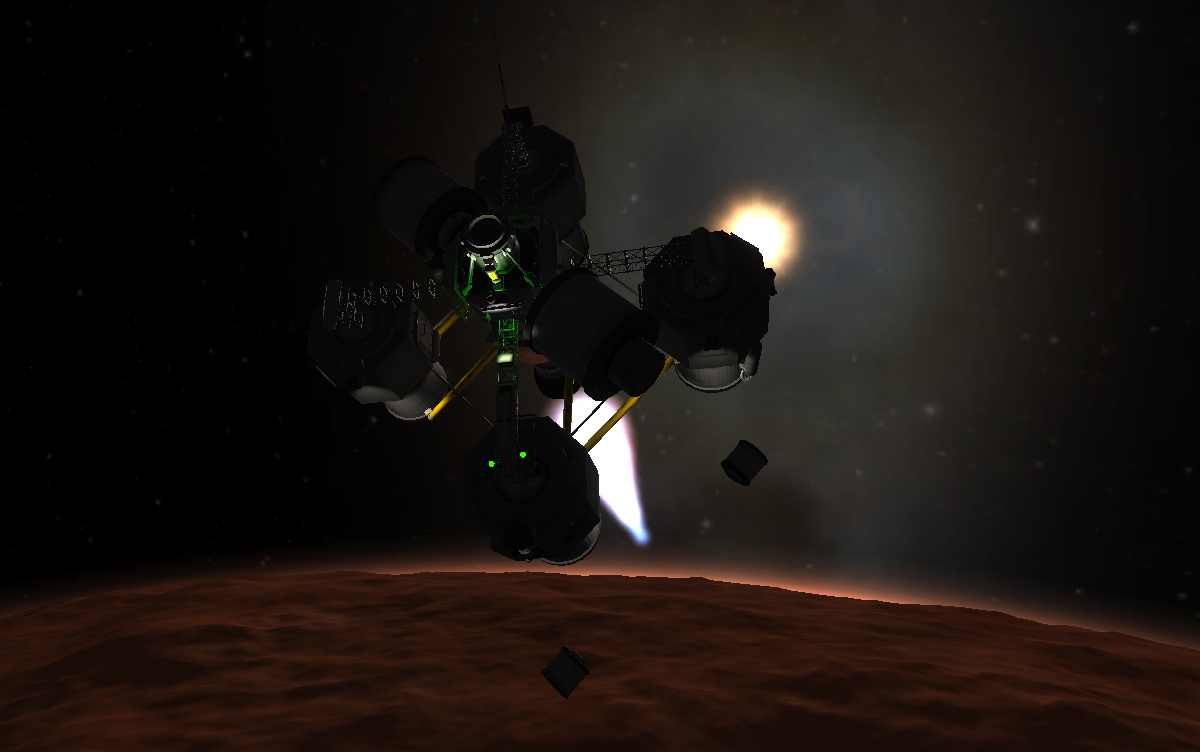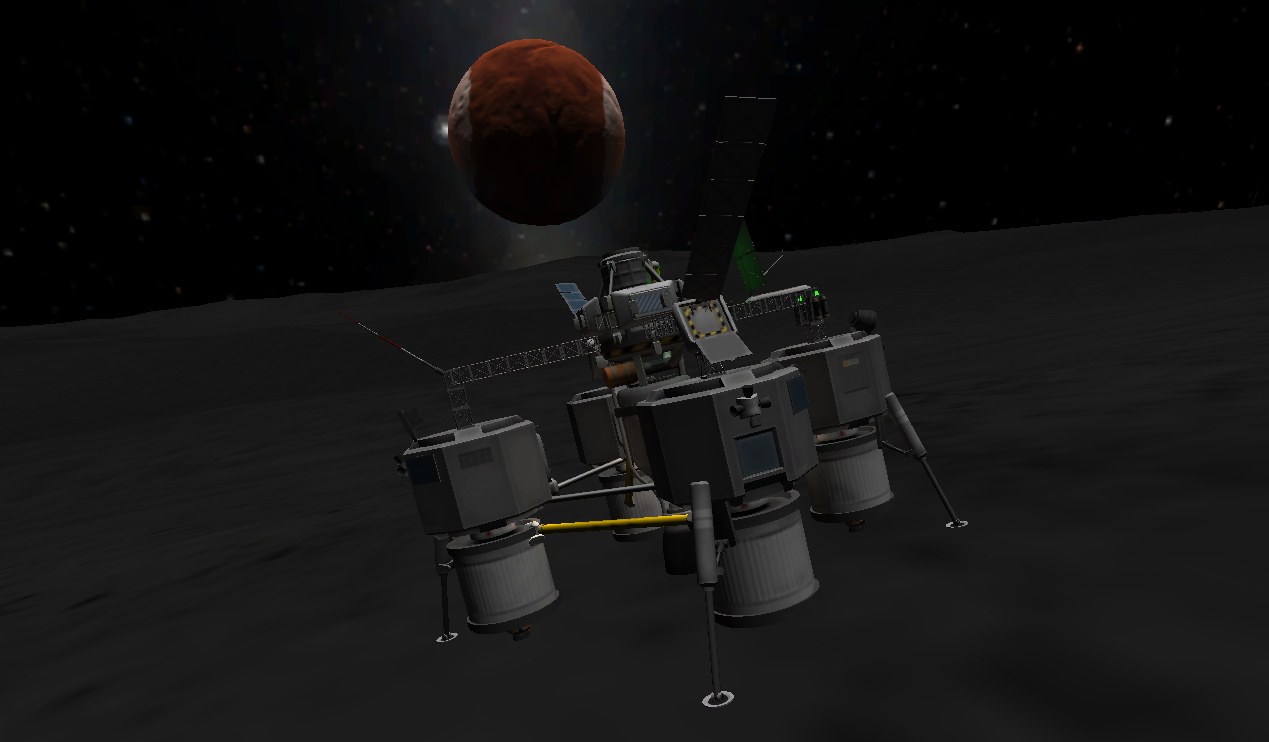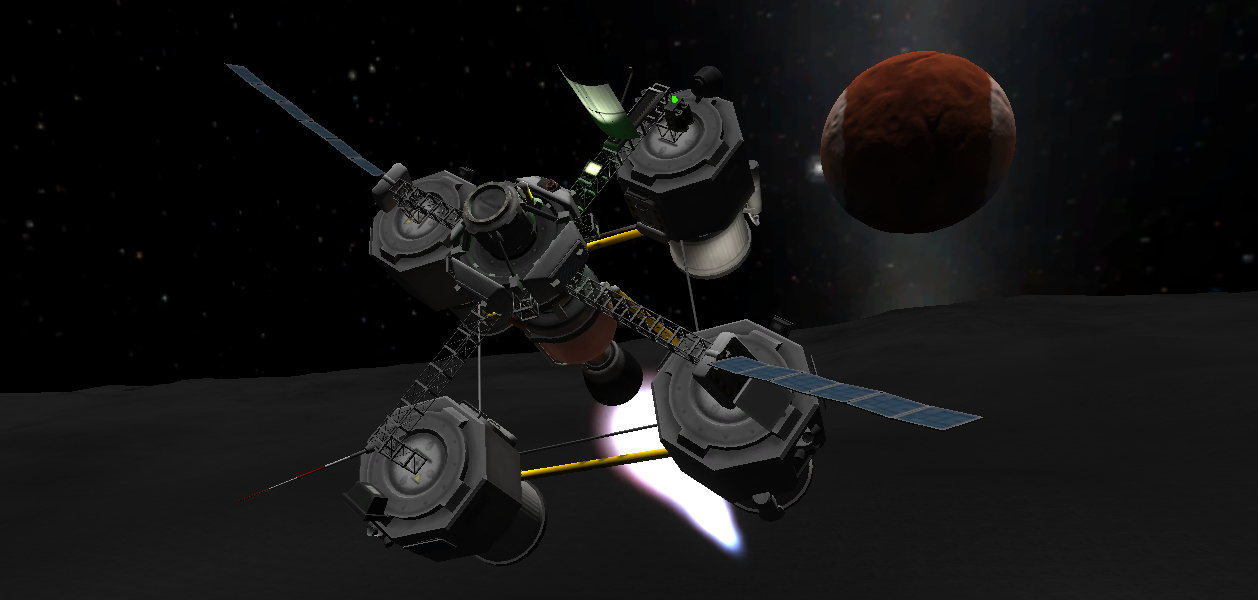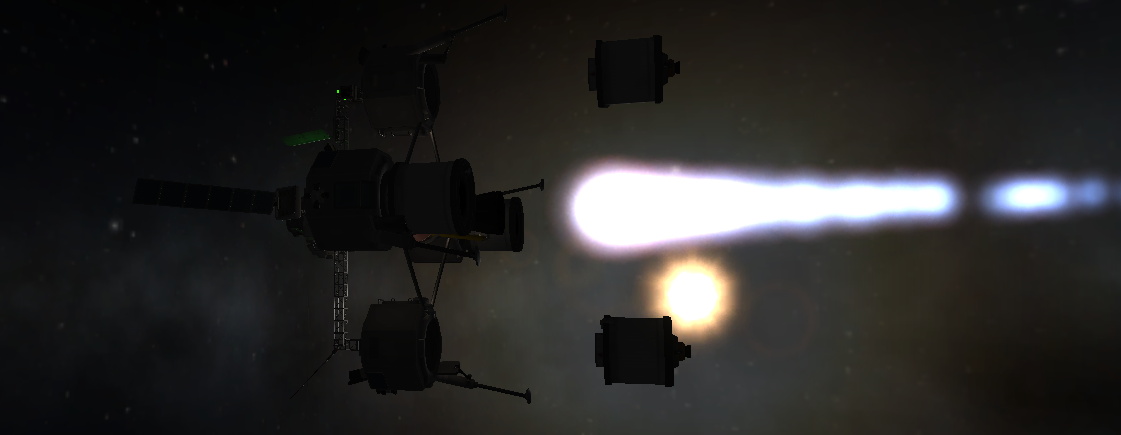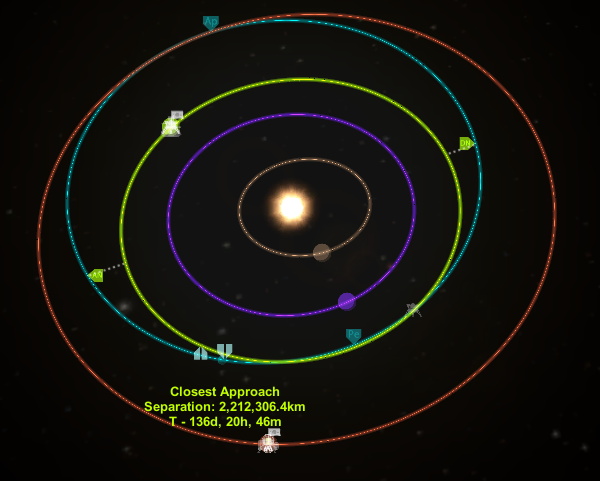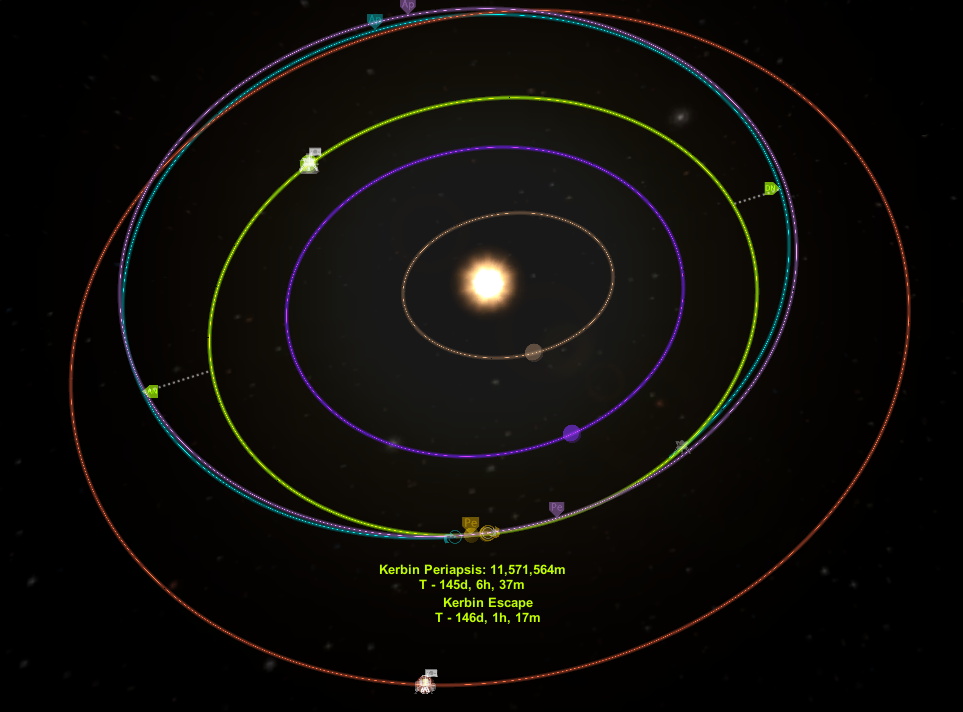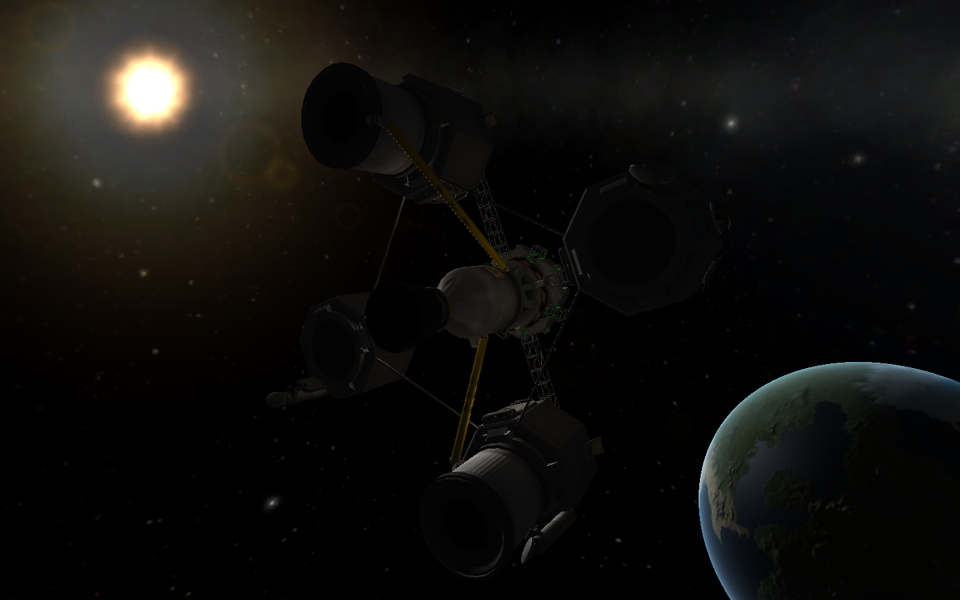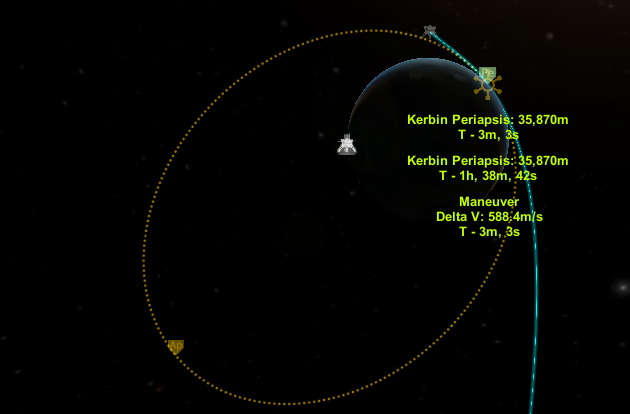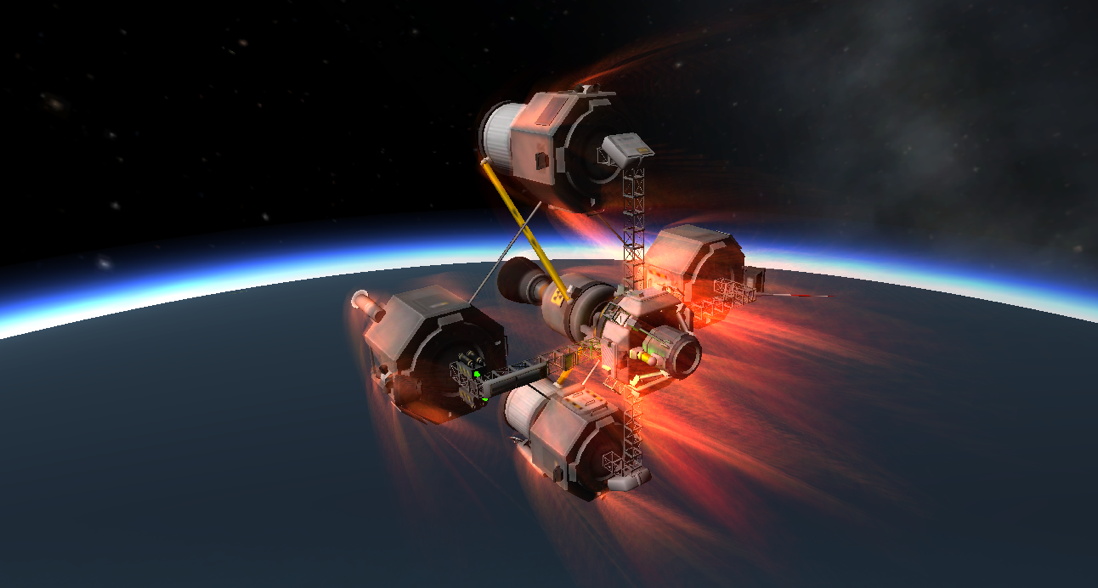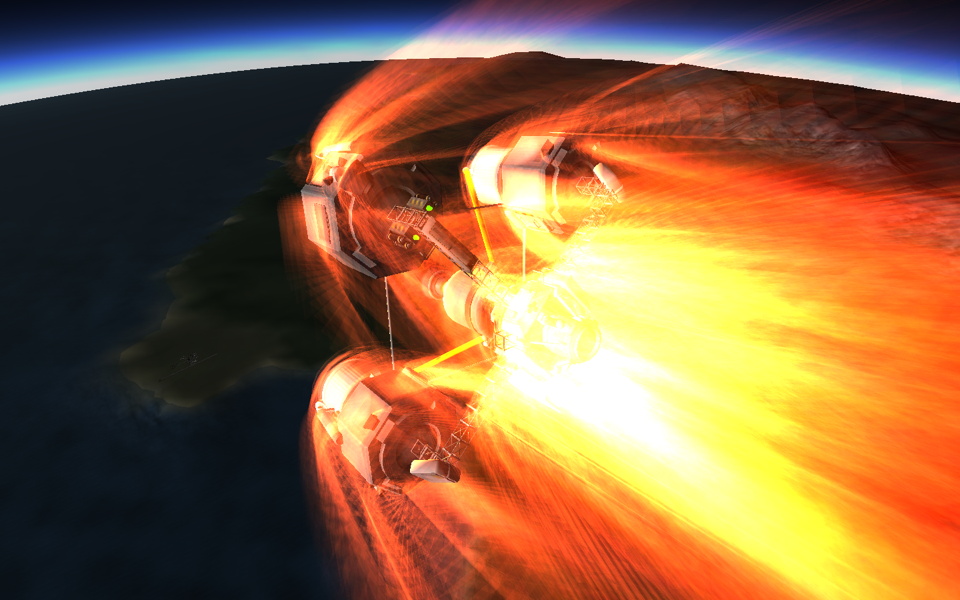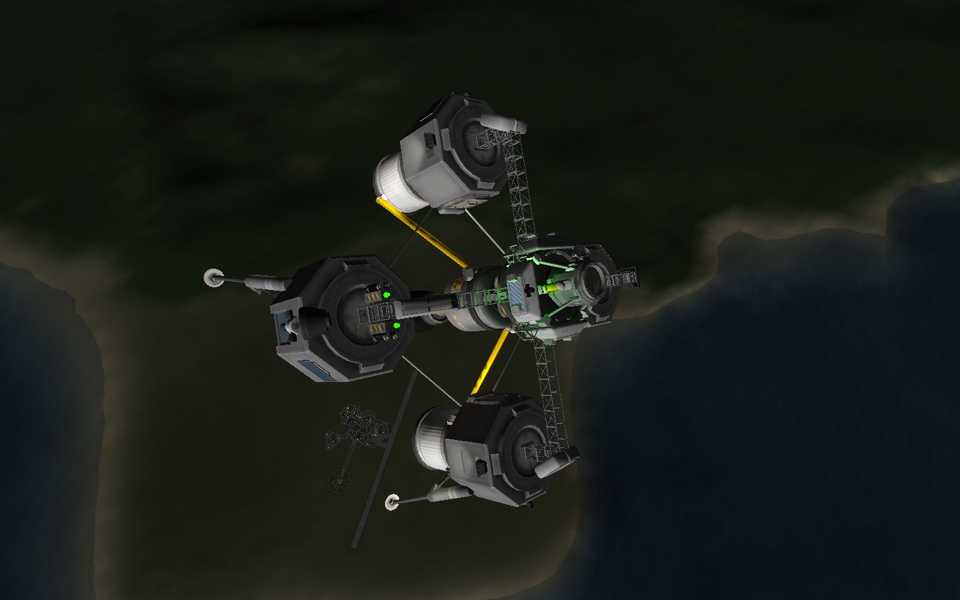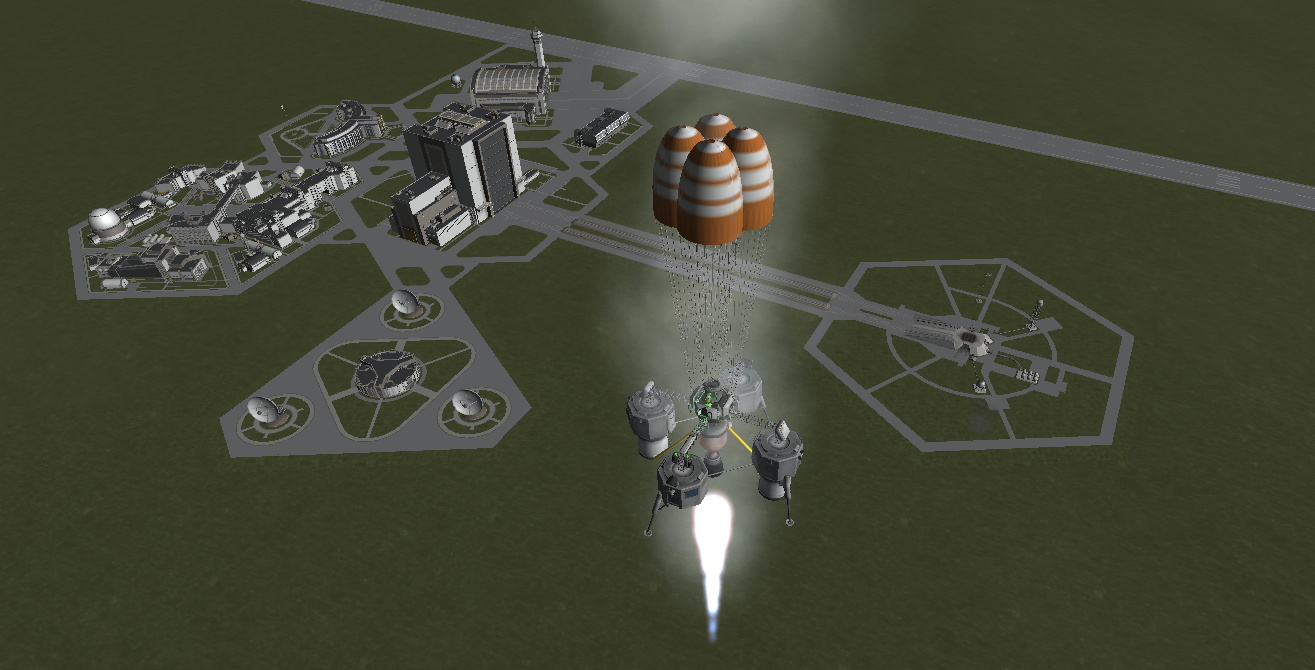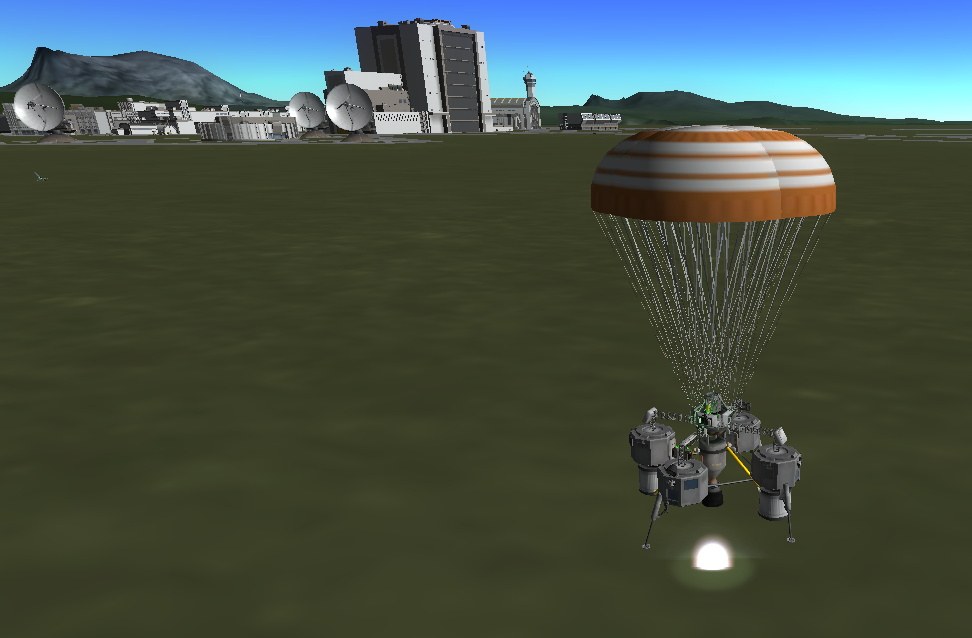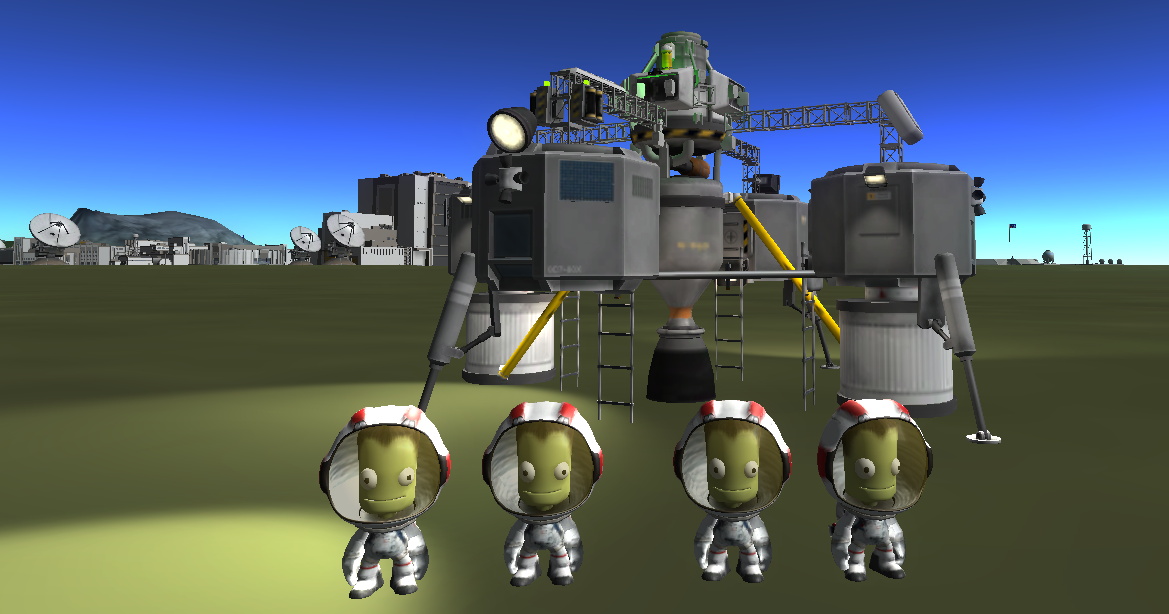- Joined
- Jan 17, 2009
- Messages
- 5,204
- Reaction score
- 1,547
New KSP mission, to "Mars" (Duna) and back.
Another mission, using the same vehicles and spacecraft as before, plus a new Rover and some mods to the SSTO Space Plane to give it the capability to deliver a useful payload into orbit.
I'm going to tell this one more in a fictional story style than the other ones. I'm not trying write a true sci-fi story, just a plausible narrative of the mission. Well, plausible in the Kerbalverse.
For those who have not followed and wonder "WFT" this is, see this thread first:
https://www.rocketryforum.com/showt...(was-a-mission-to-send-a-Spaceplane-to-moon-)
-------------------------------------------------------------------------------------------------
Picking up from the last mission:

With the success of the new Quad Lander and the totally reusable launch vehicles, planners at KSC were looking for a more advanced mission that could be done, without building any new designs. There were still repercussions from the "Joyride stunt" of flying the Space Plane to the Mun, some felt a lot of money was wasted for little scientific or technical value. So, there was pressure to do much more, on a tight budget.
A plan was made to use a new Quad lander to fly a mission to land on Duna (Game equivalent to Mars). But it did not have enough fuel to fly to Duna and return. Some argued for giving it a big fuel tank to provide the fuel to Duna, but the suitable size of tank was out of stock, not available for months.
In any case, a second launch vehicle would be needed to get a big tank into orbit. Wernher VonKerman proposed using the prototype Quad Lander, refurbished with new tanks, as a "transfer stage" to get to Duna.
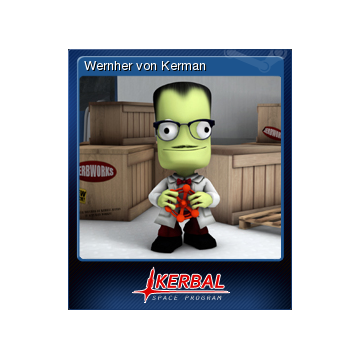
At first it seemed farfetched, but the more that the other mission planners thought about it, the more attractive it was. The old lander could push the new lander to Duna, so the new lander would not use any fuel until it began a de-orbit burn. But the old lander would not have enough fuel to get back by itself, the two would have to re-dock in Duna orbit but even so there might not be enough fuel to get both back. There were some ideas on what to do about that. Perhaps leave it unattended in Duna orbit for a future mission to bring enough fuel for it to fly back. But they went with a more adventurous plan that Jeb and Wernher worked up…….
Another piece of hardware was desired. A Rover so that the Kerbalnauts could travel long distances. The plan was to land inside of a very large crater, but they wanted to explore outside of the crater. So, an old unmanned rover was dusted off, stripped down, and reconfigured for this mission. Four seats were added.
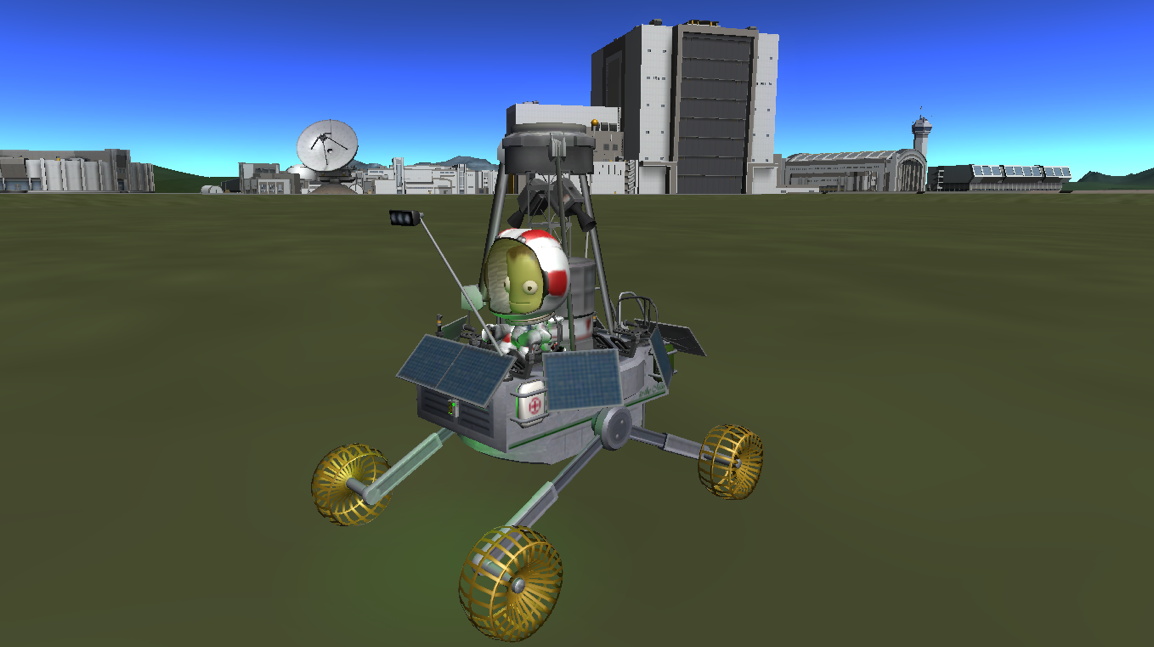
Docking ports added, at top, and bottom, because it would be docked between both landers for the trip. The new lander would carry it on top for the descent, and after landing the rover would be released. But if it was just released, it would topple off of the ship, possibly damaging it, and probably fall on its side or upside down, useless (for some reason, even with a lightweight rover in low gravity, Kerbals can never manage to grab onto and flip a rover upright). Ideally, it would be carried on the side of the lander, but the lander would be unbalanced and go out of control. Some wanted add a 2nd Rover, which would also balance the lander out. But the budget for this mission was already big enough, even with all the reusable equipment. And the mass of taking a 2nd rover would leave less fuel for the return flight. So, the rover was given a very small fuel tank with a couple of "ant" sized engines, so it could lift off from the lander and land itself safely on the ground.
Jebediah Kerman was commander for the whole mission, and flying the old Quad Lander. Flying the new Quad Lander was another top veteran, Bill Kerman. Jeb and Bill chose their own co-pilots. The top brass including Wernher (plus Jeb) chose the four other crew members, who turned out to be new people that had backgrounds in geology, chemistry, astronomy, and other sciencey-stuff that didn't have anything to do with flying rockets, so no wonder Bill and the co-pilots didn't know any of them.
As the crews prepared for the mission, and the Rover was being completed, the launch vehicle for the Rover was being modified. The 2-stage reusable rockets were great, but the mass of a Quad Lander was the most they could get into orbit and still have fuel reserves to land back at KSC for re-use. The Rover needed to get into orbit by another way. And it had to be cheap. So, an existing smaller reusable launch vehicle was modified to do the job. Being turned from a 1-person space taxi to something more like a flatbed pickup truck…. whatever a flatbed or a pickup or a truck was (they have no such things on Kerbin, that anyone knows of).
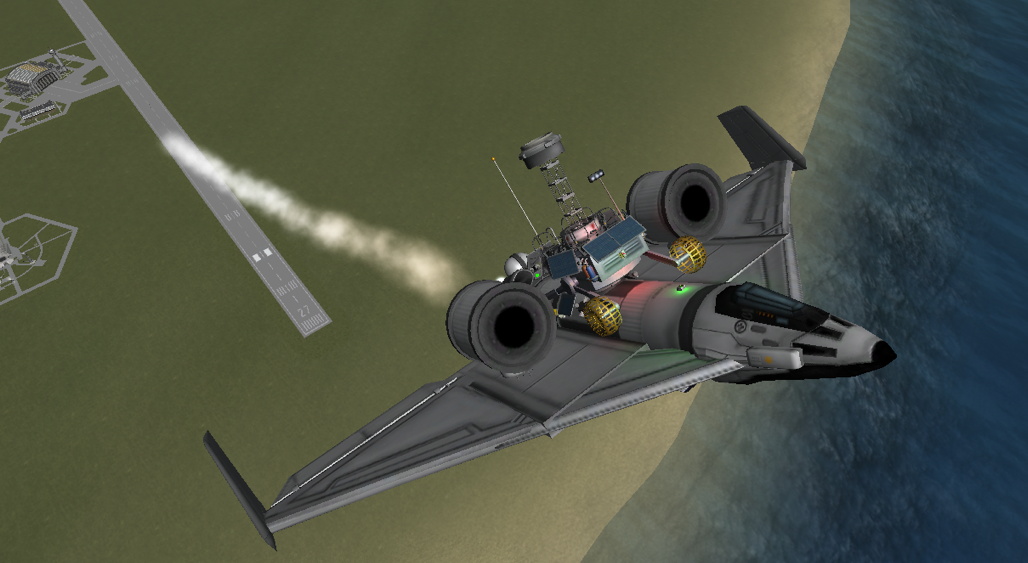
The Rover was launched first, carried on the top of the SSTO Spaceplane. The Spaceplane needed more fuel to be able to carry a payload into orbit, so two 400 liter tanks were added as drop tanks. The plane needed a much longer runway run before it took off, but it got into air safely. The climb on jet power was slow and boring, particularly the gradual climb from 15 to 25 kilometers. As the speed built up to nearly half of orbital velocity, the pilot tried to squeeze out more speed by climbing a bit more without automatically tripping the engine from jet to rocket mode. The plane became hard to control and he was distracted by correcting the flight, not noticing that the RAPIER engine had kicked in from Jet mode (sipping fuel) to Rocket mode (gulping fuel and oxidizer). By the time he realized it and drastically increased the climb angle, a lot of fuel and oxidizer had been used. The ship was nearly into orbit, too late to abort. The "drop tanks" were empty, but there was enough fuel left in the fuselage tanks to make orbit, so there was no need to jettison the drop tanks. After the flight, when he was debriefed, he'd say that he realized the performance was so good that he decided not to drop the tanks, saving more money for the program (and letting the plane keep its SSTO status). Yeah, that's it, nobody needs to know the control issues in the last part of jet flight had distracted him from realizing the engine had gone to rocket mode.
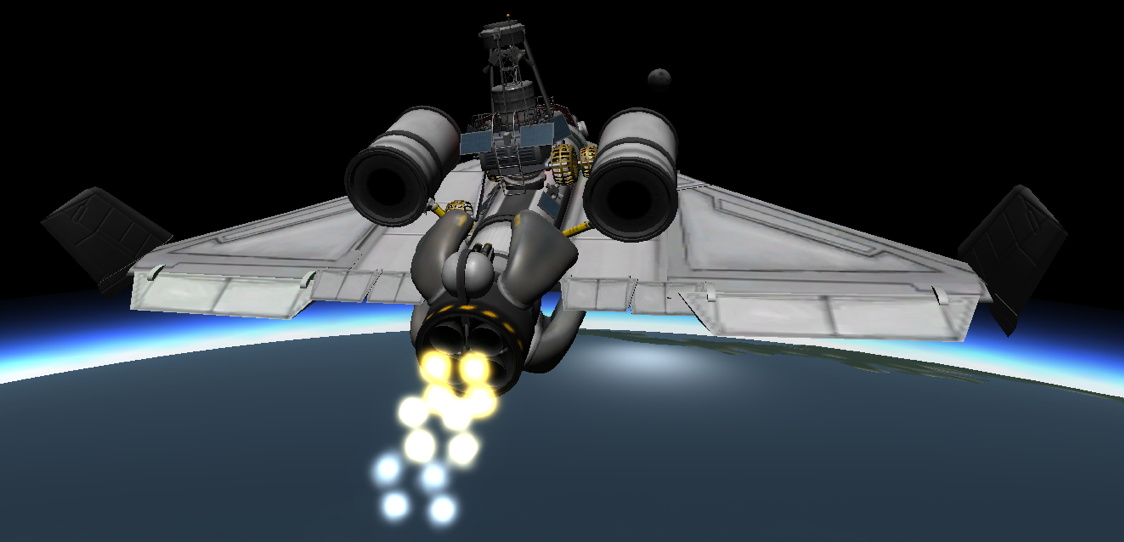
With the newly designated SSTO Space Truck in a stable orbit, the old Quad Lander was launched, with Jeb in command. The reusable rocket worked perfectly, getting the lander into orbit, a bit behind of the Space Truck , in a bit lower orbit so that orbital mechanics would help to get the two closer for rendezvous. The Space Truck took the active role of performing the rendezvous, getting with 50 meters of the Lander. Then Jeb took over to do the docking with the Space Truck. The very bright lights of the Rover were turned on, helping to light up both ships, making it easier to see for the docking on the night side of the planet.
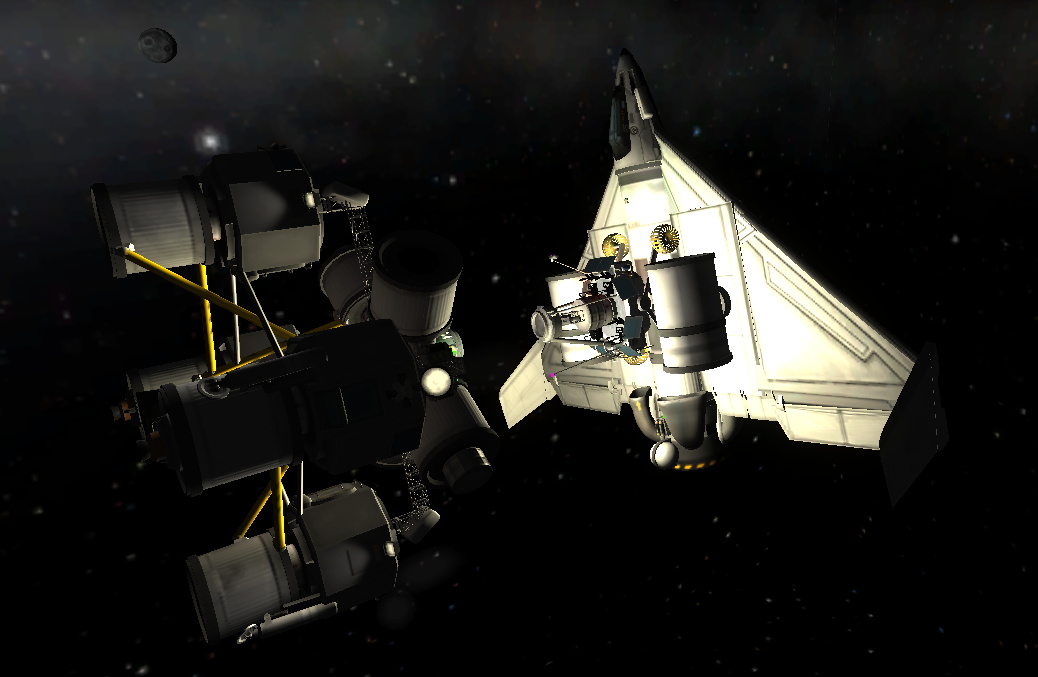
Finally Jeb docked with the Rover and the ships were all connected.
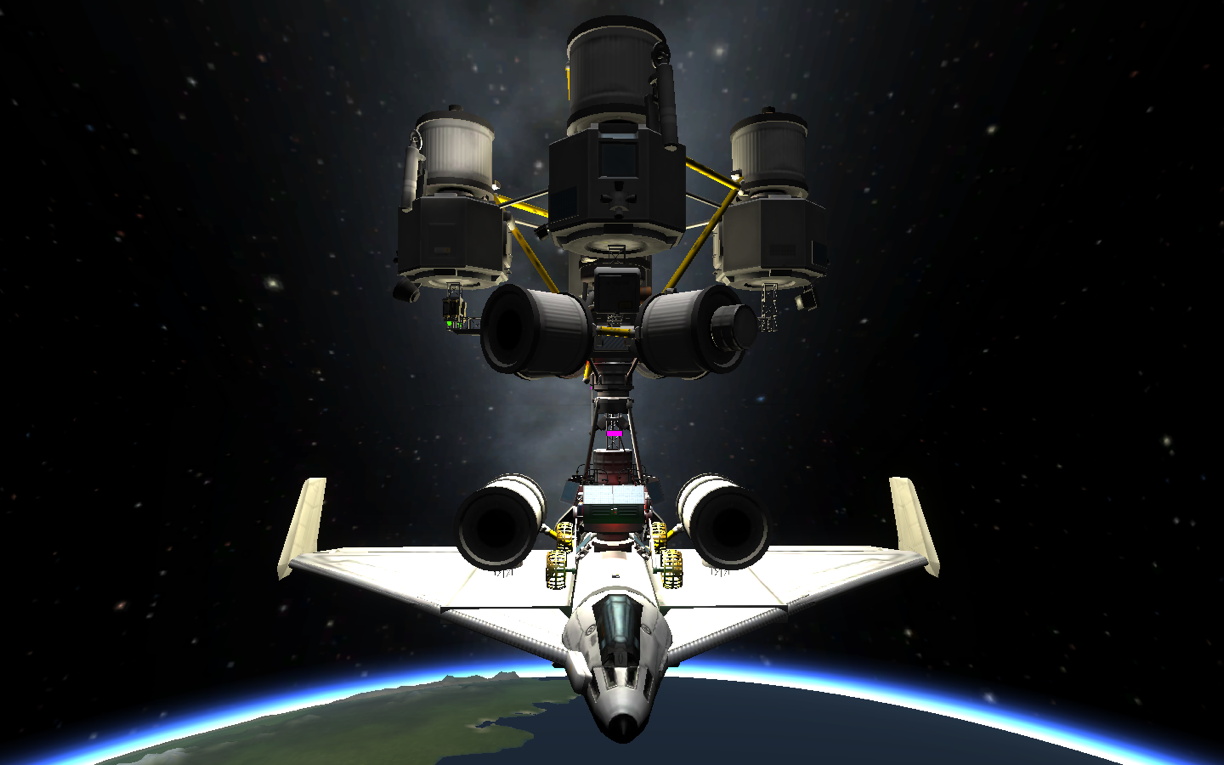
Jeb transferred some RCS fuel from the Space Truck to top off the lander's RCS tanks. Then Jeb had the Rover's lower docking port release from the Space Truck. The Space Truck backed away, and did a de-orbit burn to return to KSC. Engineers at KSC were not 100% sure it could safely re-enter and land with the empty drop tanks onboard, but if the pilot was OK with it, they were OK with it. Fortunately, there were no problems with re-entry, and it landed safely on KSC's runway.
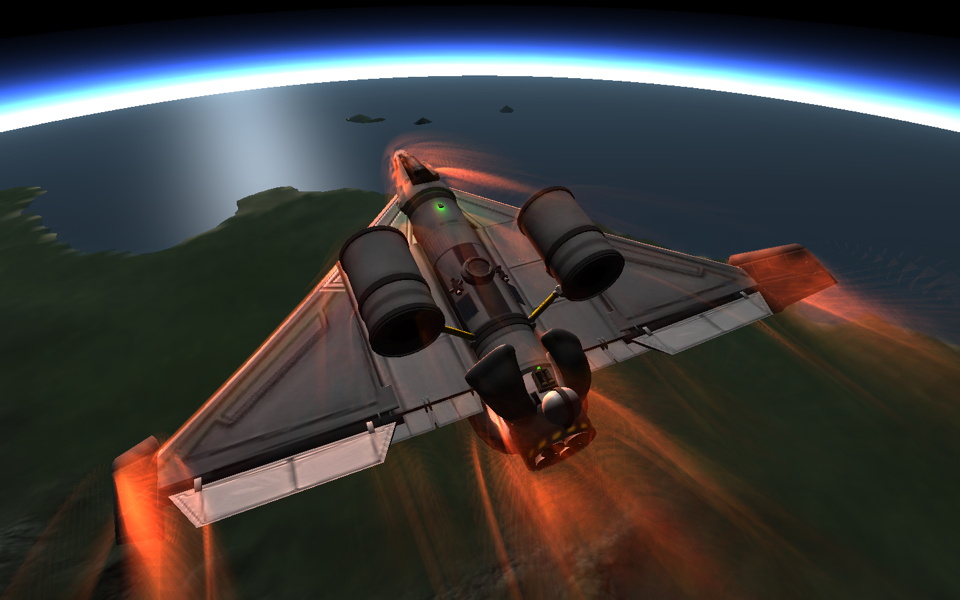
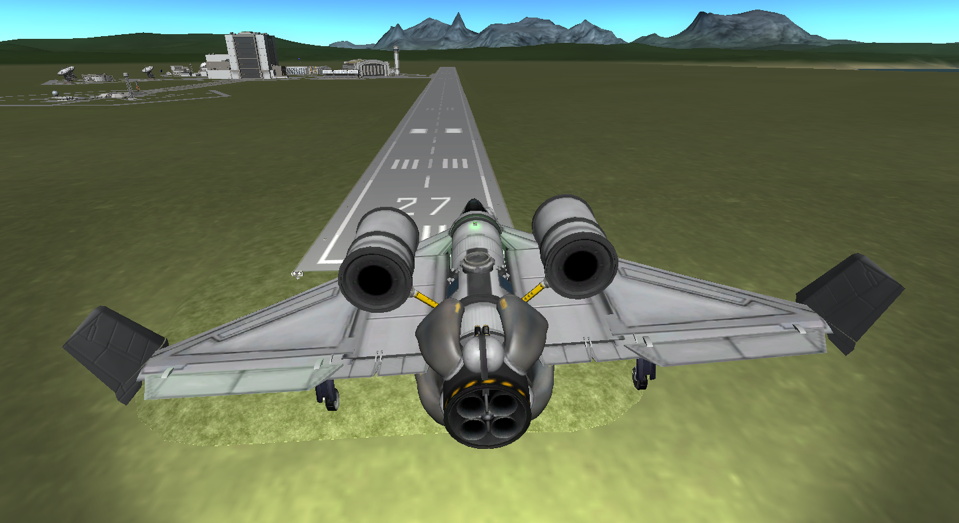
Meanwhile, the new Quad lander, piloted by Bill Kerman, had been safely launched, and all of its rocket stages had landed safely at KSC, before the Space Truck was give the OK to land. With both landers in orbit near each other, Jeb carefully performed a rendezvous and docked successfuly
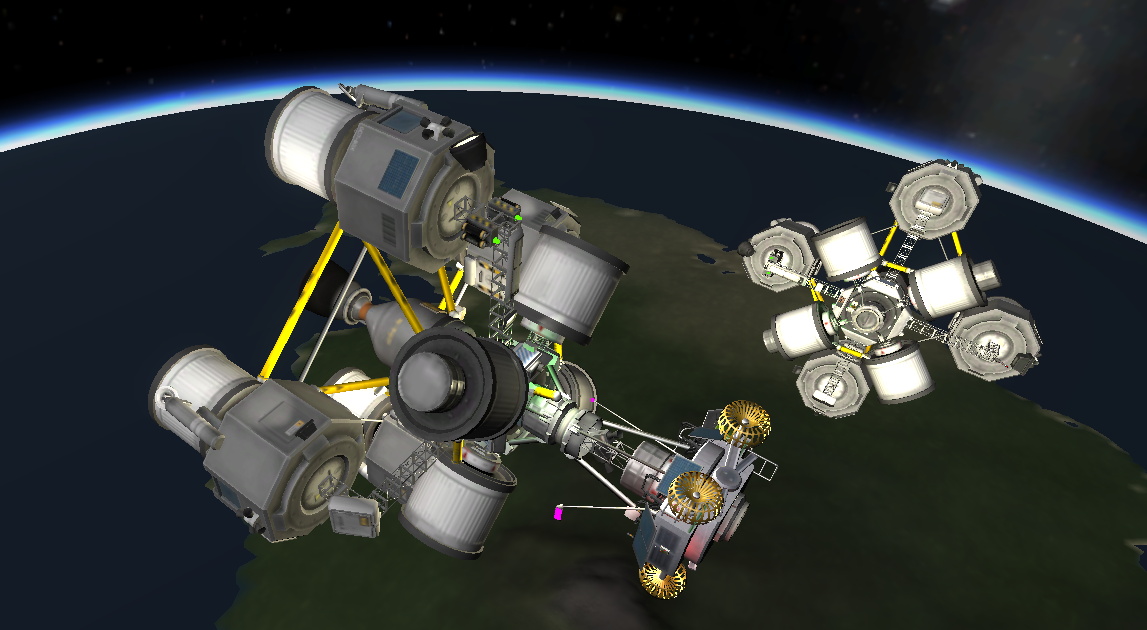
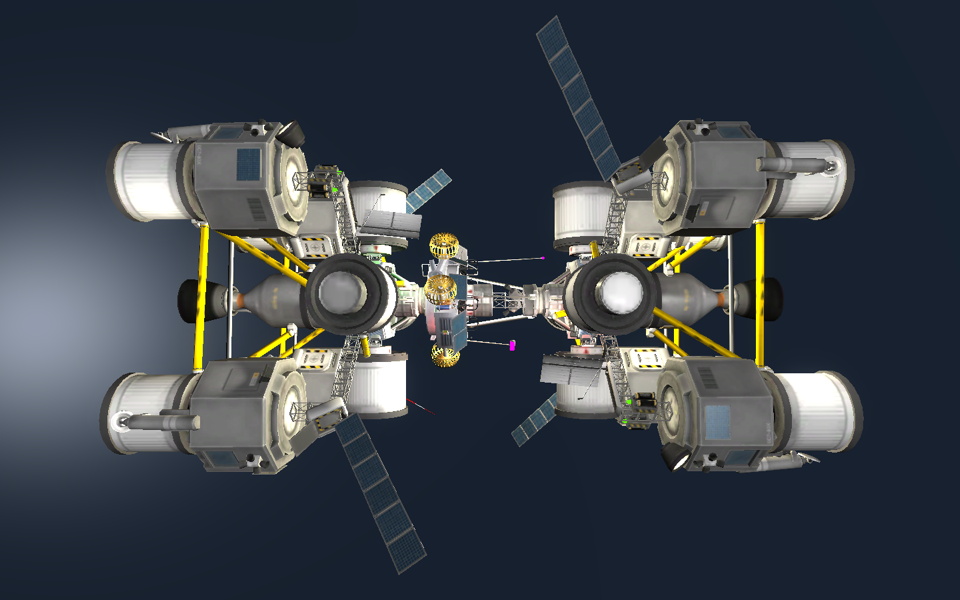
Jeb fired up the old lander's nuclear engine to accelerate the combined ships on the desired trajectory to reach escape velocity to leave Kerbin's gravitational sphere of influence.
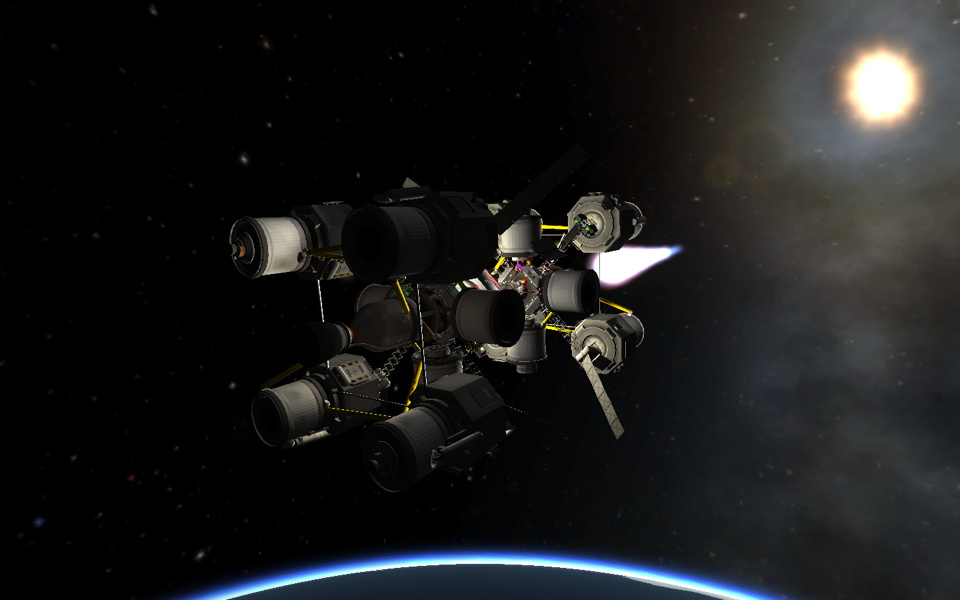
With a thrust to weight ratio of only .18, it accelerated slowly. So slowly that once the projected apoapsis was raised to 1000 kilometers, the engine was shut down. The ship coasted for nearly an orbit, a very elliptical orbit, until nearly down back to periapsis near the planet. Then he fired up the engine again to complete the burn to slowly increase the apoapsis until it reached escape velocity. This process of doing multiple burns when closest to a gravitational body increases efficiency due to the "Oberth Effect", but nobody on Kerbin knows why it is called that (Kerbin history does not record any Kerbal named Oberth *)
With the combined ship away from Kerbin, and into solar orbit, Jeb entered in final data in the computer to project a trajectory to go to Duna. After the burn, the ship's path would take it to within 30,000 km of Duna in 78 days.
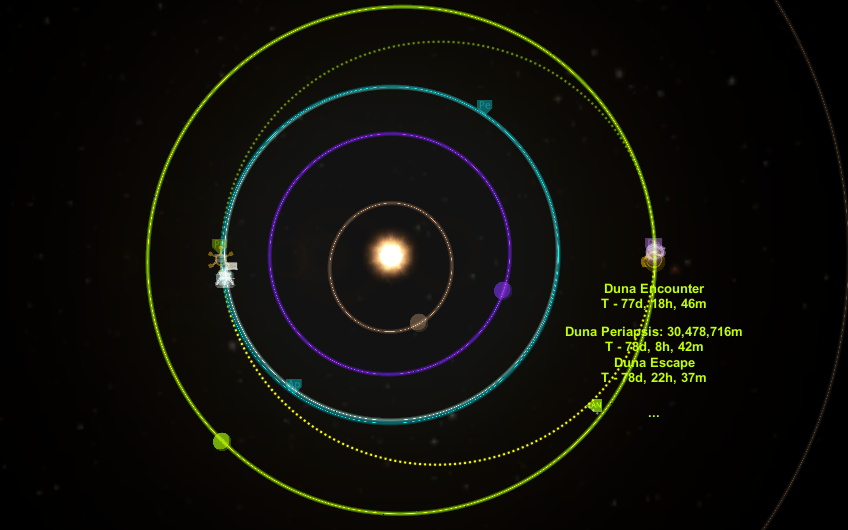
The time from then until getting near Duna was pretty boring, but Kerbalnauts are used to long flights. At least this one would not take many years like flights to Jool (Jupiter) or Eeelo (Pluto). And there were eight crew members, even if they could not go visit inside another crew module. At least they could talk to each other real-time, the time lag over vast distances made 2-way talk with people on Kerbin more and more impractical after the first few days. Plus of course, many Kerrabytes of electronic books, music, and videos for entertainment during the trip.
Finally nearing Duna, Jeb and Bill worked out a course correction to make to get a better encounter with Duna. The first burn worked well. Then a final tweak burn to bring the periapsis down to nearly 13 km for aerobraking.
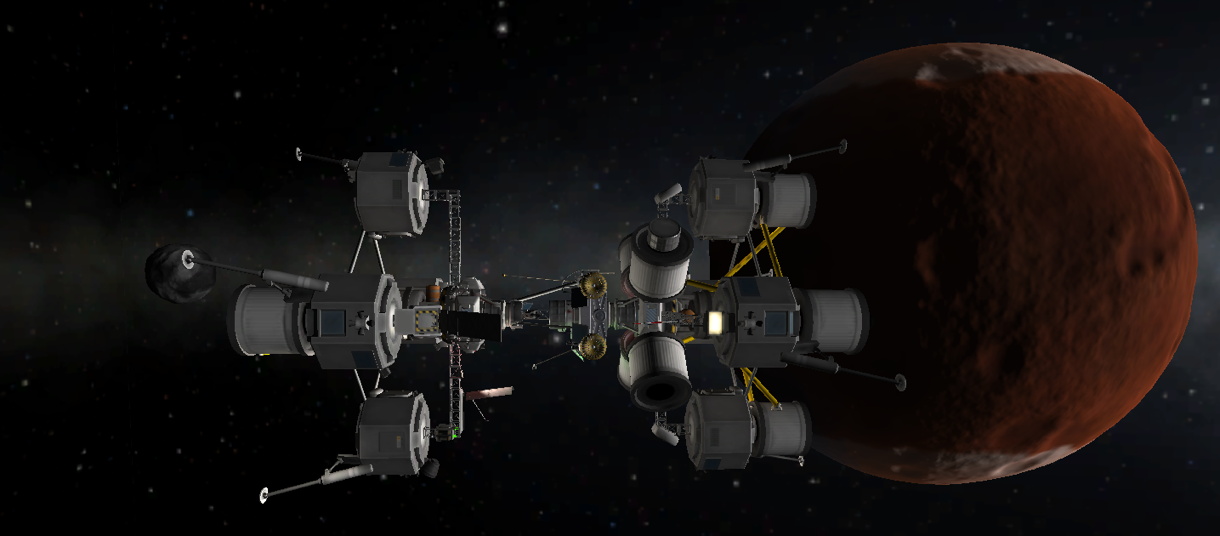
With the ship dipping into the thin atmosphere down to nearly 13 km above the surface, the trajectory changed from one that would escape Duna, to an elliptical orbit. In this computer projection the current orbit in blue is shrinking down to the one projected for the aerobrake after completion (brown dotted line)
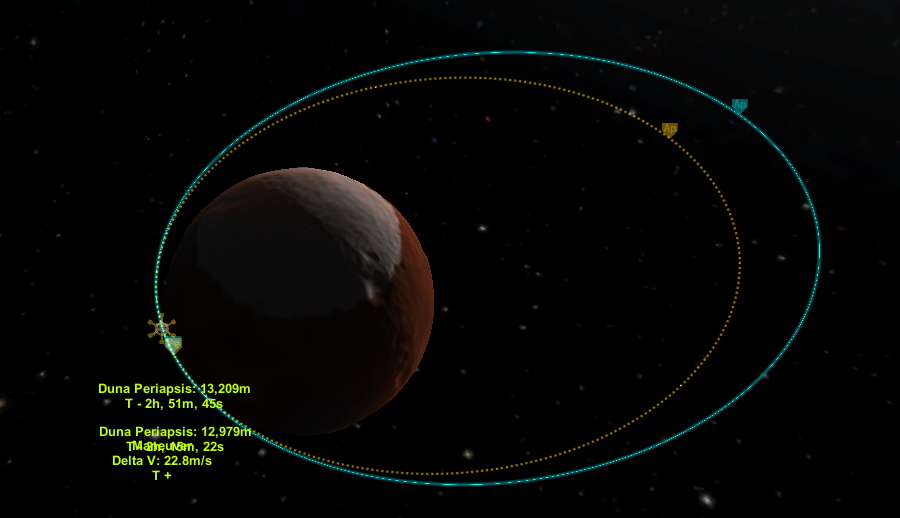
After that, another set of burns and a lesser aerobrake left the ship in about a 46 km orbit, 4.5 km above the atmosphere. Having seen the crater by eye and taken hi res photos from orbit, Jeb and Bill talked with one of the science team members about just what part of the big crater to land in. They chose an area that was near the southern edge, so they later would not need to travel too far to drive up the side to get outside of the crater. They wanted to land close enough to a nearly flat portion of the crater bottom for most of their exploration and gathering a lot of samples for onboard testing. They chose an area that was close to zero inclination, so that after leaving Duna the orbital path would be at zero inclination. The area also left a decent margin for error in case the landing was not as accurate as desired, landings on Duna are very tricky due to the thin atmosphere and use of parachutes in extreme conditions.
Bill was surprised that Jeb would not be swapping places with one of the science team members to join Bill aboard the new Lander, now designated Prime. Jeb stayed aboard the old lander, which did not have the fuel to land on Duna and fly back to Kerbin. The flight plan as Bill understood it was that the old lander would stay in orbit with the four science team members onboard to observe, and after the Prime lander returned from orbit it would dock back up and both ships would fly back to Kerbin.
Well, whatever. Bill almost never got to fly the ship when Jeb was onboard. So while he'd miss Jeb not landing on Duna, he'd enjoy being the one landing the ship. He undocked and shortly after began the descent burn.
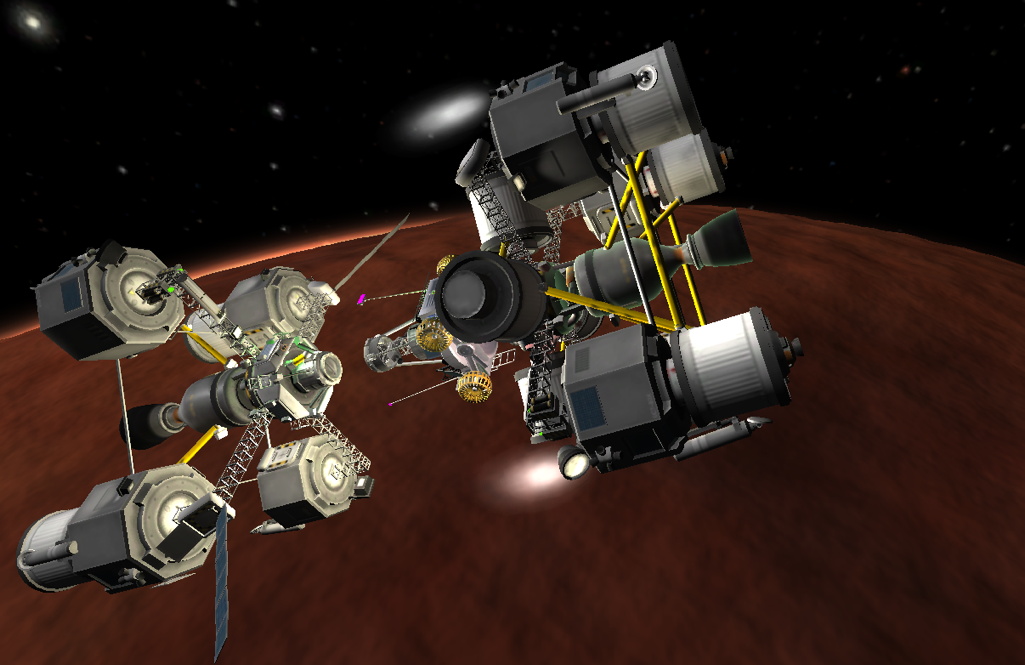
Fortunately the descent burn did not use a lot of fuel, just enough to get the ship slowed enough to enter the thin atmosphere at the desired location. The ship would not be decelerated a lot by the atmosphere though. When it had gone past peak heating, the four chutes were deployed in reefed condition, slowing this ship a little bit but still not very much as it screamed thru the air at a very shallow angle.
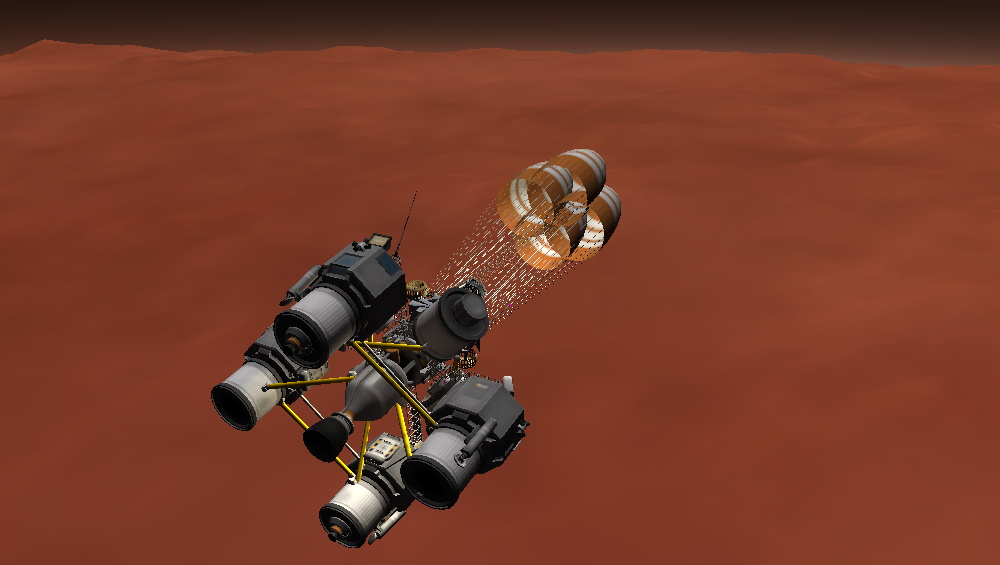
One of the chutes deployed fully as planned, to help slow the ship more, acting a bit like a drogue, then the other three deployed shortly after. Even then it took a long time for the ship to slow enough so tat it was suspended vertically under the chutes, at a reasonably low speed, but still too fast (18 m/s) to land without damage. Shortly before landing, the engine was fired up at low throttle to slow the descent rate so that it landed safely at 2 meters a second.
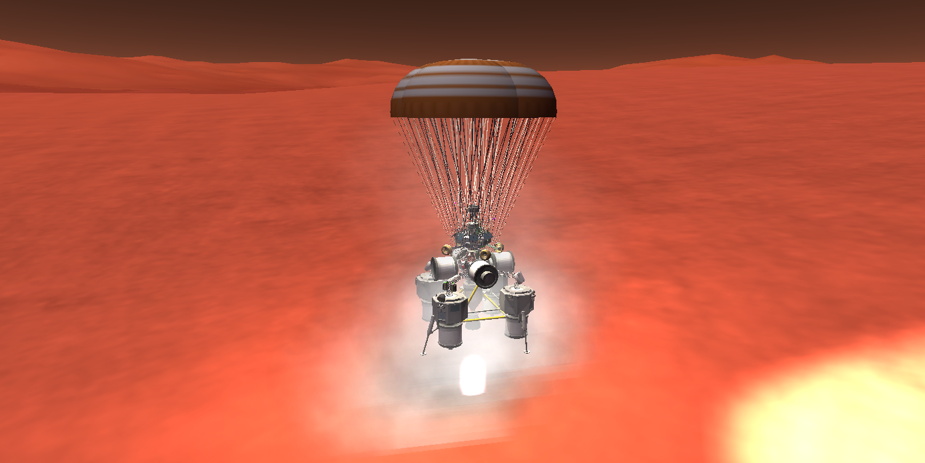
Not long after landing, the Rover was unlocked and flew itself from the top of the ship, landing safely nearby.
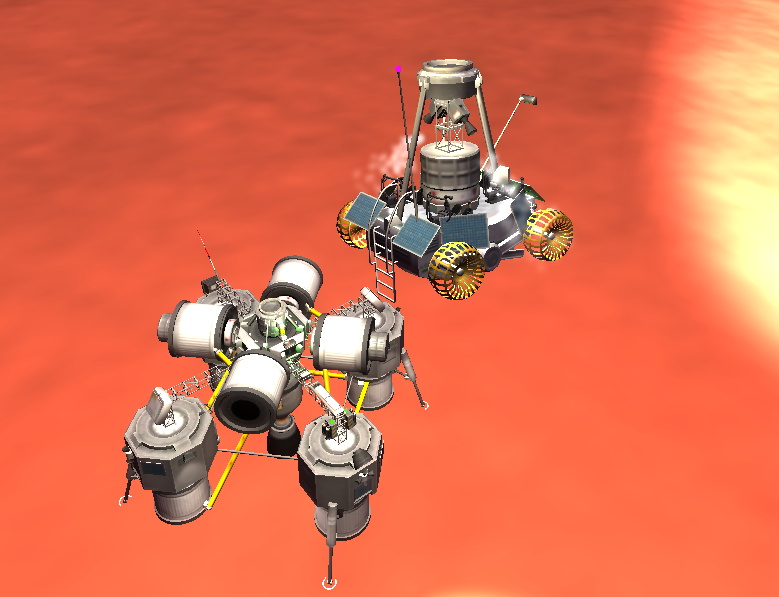
After that, Bill climbed down to set foot on Duna, and the crew later planted a flag.
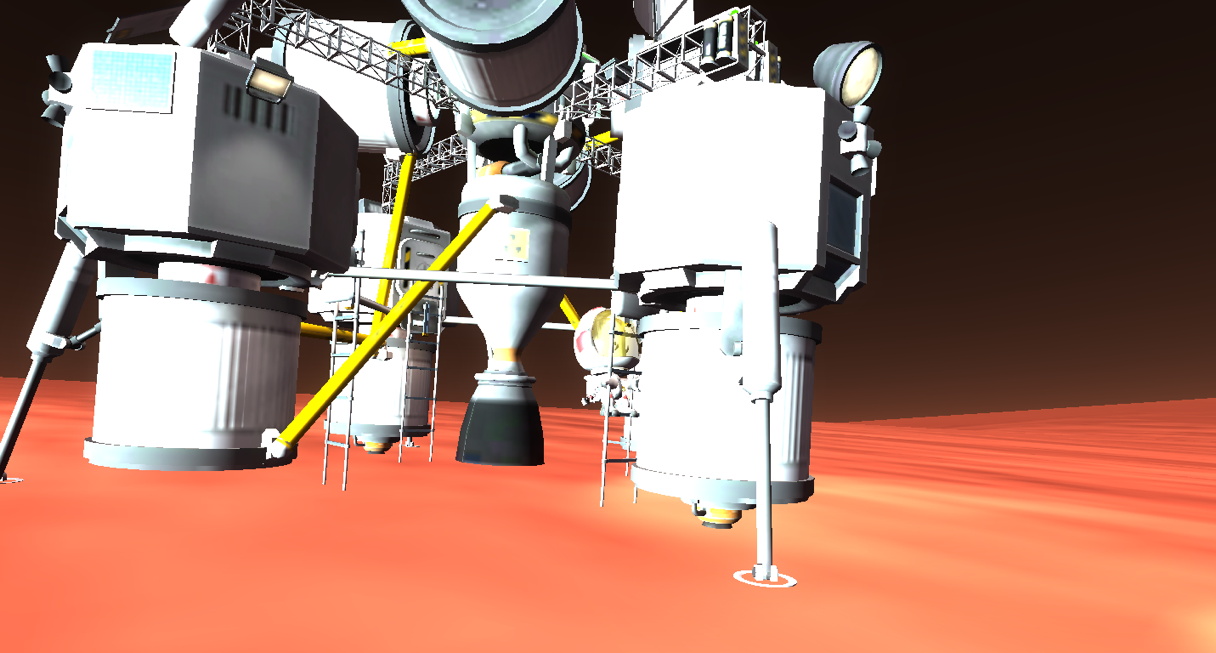
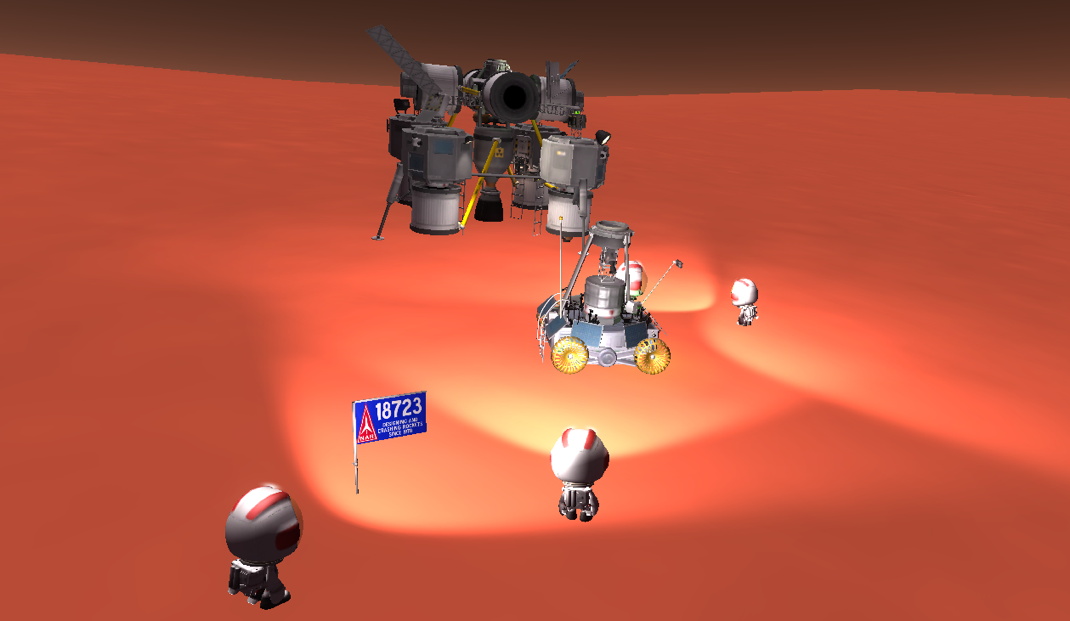
Meanwhile, in orbit around Duna, Jeb had made notes on when, where, and what altitudes where Bill had been when the chutes had been deployed, and how much the projected landing point had been affected by the chute deployment sequences. This was important because Jeb's real reason for being left on the old lander in orbit was not really to allow the lead science team member to land on Duna in the Prime lander. And the other three science team members onboard were not there just for the ride and looking out of windows.
Besides, Jeb was not 100% sure that there would be enough fuel left aboard the Prime lander to dock with the old Quad Lander use the combined fuel of both ships to get back to Kerbin. So, Jeb convinced Wernher to alter the plan and had helped to recruit four dedicated team members who were willing to take a risk, and get the opportunity to explore for months, even years, on Duna, before being flown back on a future mission. So, the old lander was not going to end up in a museum, it was going to end up as Duna Base 1.
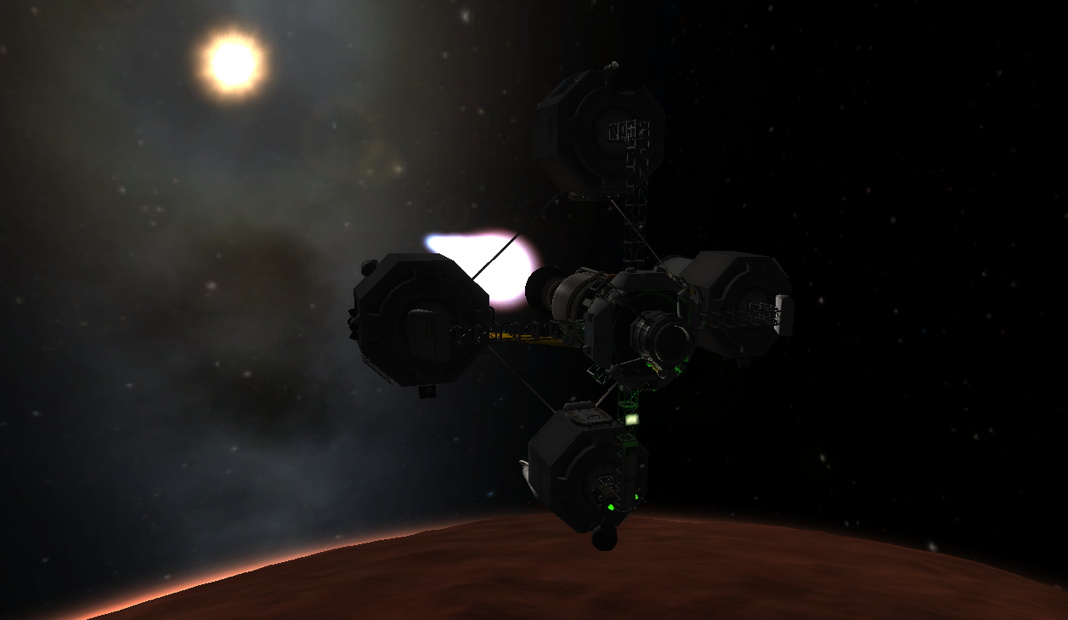
Jeb did a deorbit burn and went thru his notes to try to duplicate the key points of Bill's landing. It seemed to be coming up short though, so he did a manual burn pointing "up" (Radial +) to stretch it longer. But then it looked like t was going to end up being too long, so he deployed the chutes a bit early. The chutes were reefed as usual, then one deployed fully as intended to slow it more, then the final three. But would it be close?
Meanwhle, Bill and his crew had been checking out the ship and Rover when over the radiio they heard Jeb say "Hey, Bill, look to your east!"
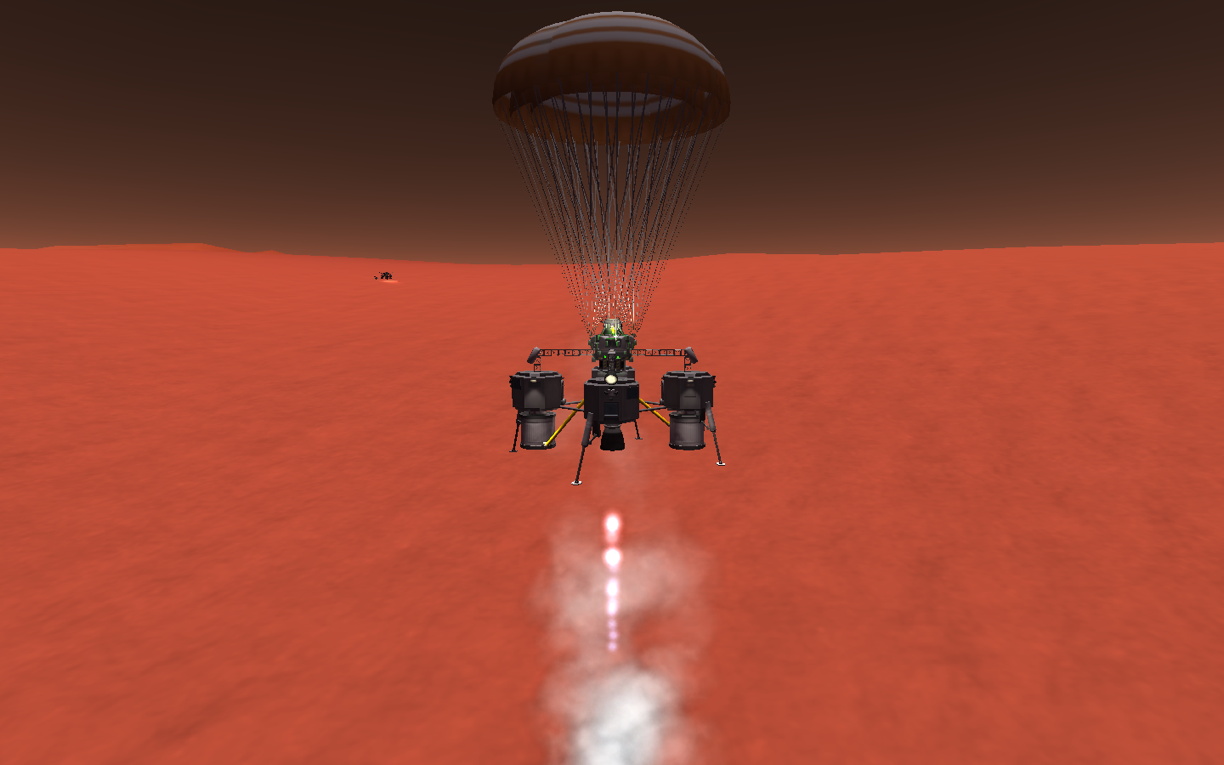
Bill was dumbstruck to see the old Quad Lander coming down under chutes, then fire up its engine and land about 500 meters to the east. He thought to himself - WFT? (What Fun Thrust, or something like that).
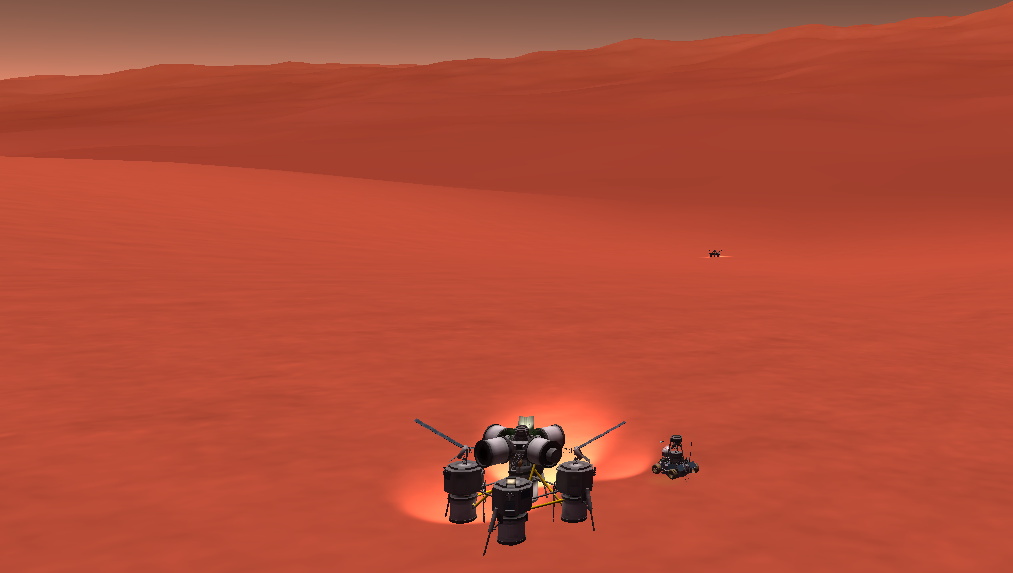
After the landing Jeb finally explained by radio what was going on, Bill and his crew drove over to the new Base to meet up with Jeb and his crew.
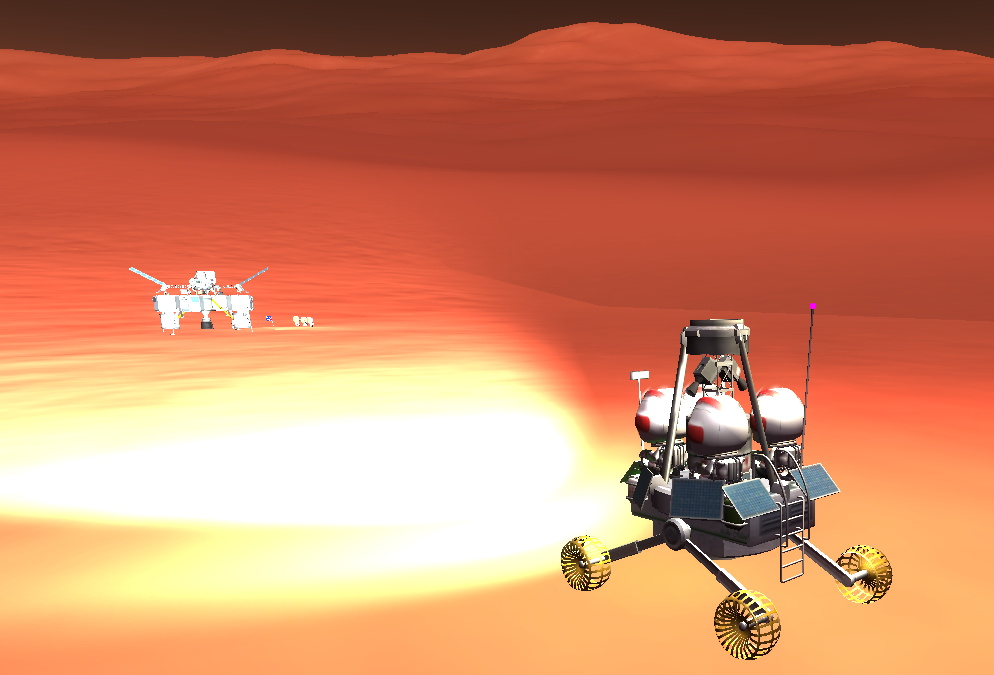
Continued next message.....
Another mission, using the same vehicles and spacecraft as before, plus a new Rover and some mods to the SSTO Space Plane to give it the capability to deliver a useful payload into orbit.
I'm going to tell this one more in a fictional story style than the other ones. I'm not trying write a true sci-fi story, just a plausible narrative of the mission. Well, plausible in the Kerbalverse.
For those who have not followed and wonder "WFT" this is, see this thread first:
https://www.rocketryforum.com/showt...(was-a-mission-to-send-a-Spaceplane-to-moon-)
-------------------------------------------------------------------------------------------------
Picking up from the last mission:

With the success of the new Quad Lander and the totally reusable launch vehicles, planners at KSC were looking for a more advanced mission that could be done, without building any new designs. There were still repercussions from the "Joyride stunt" of flying the Space Plane to the Mun, some felt a lot of money was wasted for little scientific or technical value. So, there was pressure to do much more, on a tight budget.
A plan was made to use a new Quad lander to fly a mission to land on Duna (Game equivalent to Mars). But it did not have enough fuel to fly to Duna and return. Some argued for giving it a big fuel tank to provide the fuel to Duna, but the suitable size of tank was out of stock, not available for months.
In any case, a second launch vehicle would be needed to get a big tank into orbit. Wernher VonKerman proposed using the prototype Quad Lander, refurbished with new tanks, as a "transfer stage" to get to Duna.

At first it seemed farfetched, but the more that the other mission planners thought about it, the more attractive it was. The old lander could push the new lander to Duna, so the new lander would not use any fuel until it began a de-orbit burn. But the old lander would not have enough fuel to get back by itself, the two would have to re-dock in Duna orbit but even so there might not be enough fuel to get both back. There were some ideas on what to do about that. Perhaps leave it unattended in Duna orbit for a future mission to bring enough fuel for it to fly back. But they went with a more adventurous plan that Jeb and Wernher worked up…….
Another piece of hardware was desired. A Rover so that the Kerbalnauts could travel long distances. The plan was to land inside of a very large crater, but they wanted to explore outside of the crater. So, an old unmanned rover was dusted off, stripped down, and reconfigured for this mission. Four seats were added.

Docking ports added, at top, and bottom, because it would be docked between both landers for the trip. The new lander would carry it on top for the descent, and after landing the rover would be released. But if it was just released, it would topple off of the ship, possibly damaging it, and probably fall on its side or upside down, useless (for some reason, even with a lightweight rover in low gravity, Kerbals can never manage to grab onto and flip a rover upright). Ideally, it would be carried on the side of the lander, but the lander would be unbalanced and go out of control. Some wanted add a 2nd Rover, which would also balance the lander out. But the budget for this mission was already big enough, even with all the reusable equipment. And the mass of taking a 2nd rover would leave less fuel for the return flight. So, the rover was given a very small fuel tank with a couple of "ant" sized engines, so it could lift off from the lander and land itself safely on the ground.
Jebediah Kerman was commander for the whole mission, and flying the old Quad Lander. Flying the new Quad Lander was another top veteran, Bill Kerman. Jeb and Bill chose their own co-pilots. The top brass including Wernher (plus Jeb) chose the four other crew members, who turned out to be new people that had backgrounds in geology, chemistry, astronomy, and other sciencey-stuff that didn't have anything to do with flying rockets, so no wonder Bill and the co-pilots didn't know any of them.
As the crews prepared for the mission, and the Rover was being completed, the launch vehicle for the Rover was being modified. The 2-stage reusable rockets were great, but the mass of a Quad Lander was the most they could get into orbit and still have fuel reserves to land back at KSC for re-use. The Rover needed to get into orbit by another way. And it had to be cheap. So, an existing smaller reusable launch vehicle was modified to do the job. Being turned from a 1-person space taxi to something more like a flatbed pickup truck…. whatever a flatbed or a pickup or a truck was (they have no such things on Kerbin, that anyone knows of).

The Rover was launched first, carried on the top of the SSTO Spaceplane. The Spaceplane needed more fuel to be able to carry a payload into orbit, so two 400 liter tanks were added as drop tanks. The plane needed a much longer runway run before it took off, but it got into air safely. The climb on jet power was slow and boring, particularly the gradual climb from 15 to 25 kilometers. As the speed built up to nearly half of orbital velocity, the pilot tried to squeeze out more speed by climbing a bit more without automatically tripping the engine from jet to rocket mode. The plane became hard to control and he was distracted by correcting the flight, not noticing that the RAPIER engine had kicked in from Jet mode (sipping fuel) to Rocket mode (gulping fuel and oxidizer). By the time he realized it and drastically increased the climb angle, a lot of fuel and oxidizer had been used. The ship was nearly into orbit, too late to abort. The "drop tanks" were empty, but there was enough fuel left in the fuselage tanks to make orbit, so there was no need to jettison the drop tanks. After the flight, when he was debriefed, he'd say that he realized the performance was so good that he decided not to drop the tanks, saving more money for the program (and letting the plane keep its SSTO status). Yeah, that's it, nobody needs to know the control issues in the last part of jet flight had distracted him from realizing the engine had gone to rocket mode.

With the newly designated SSTO Space Truck in a stable orbit, the old Quad Lander was launched, with Jeb in command. The reusable rocket worked perfectly, getting the lander into orbit, a bit behind of the Space Truck , in a bit lower orbit so that orbital mechanics would help to get the two closer for rendezvous. The Space Truck took the active role of performing the rendezvous, getting with 50 meters of the Lander. Then Jeb took over to do the docking with the Space Truck. The very bright lights of the Rover were turned on, helping to light up both ships, making it easier to see for the docking on the night side of the planet.

Finally Jeb docked with the Rover and the ships were all connected.

Jeb transferred some RCS fuel from the Space Truck to top off the lander's RCS tanks. Then Jeb had the Rover's lower docking port release from the Space Truck. The Space Truck backed away, and did a de-orbit burn to return to KSC. Engineers at KSC were not 100% sure it could safely re-enter and land with the empty drop tanks onboard, but if the pilot was OK with it, they were OK with it. Fortunately, there were no problems with re-entry, and it landed safely on KSC's runway.


Meanwhile, the new Quad lander, piloted by Bill Kerman, had been safely launched, and all of its rocket stages had landed safely at KSC, before the Space Truck was give the OK to land. With both landers in orbit near each other, Jeb carefully performed a rendezvous and docked successfuly


Jeb fired up the old lander's nuclear engine to accelerate the combined ships on the desired trajectory to reach escape velocity to leave Kerbin's gravitational sphere of influence.

With a thrust to weight ratio of only .18, it accelerated slowly. So slowly that once the projected apoapsis was raised to 1000 kilometers, the engine was shut down. The ship coasted for nearly an orbit, a very elliptical orbit, until nearly down back to periapsis near the planet. Then he fired up the engine again to complete the burn to slowly increase the apoapsis until it reached escape velocity. This process of doing multiple burns when closest to a gravitational body increases efficiency due to the "Oberth Effect", but nobody on Kerbin knows why it is called that (Kerbin history does not record any Kerbal named Oberth *)
With the combined ship away from Kerbin, and into solar orbit, Jeb entered in final data in the computer to project a trajectory to go to Duna. After the burn, the ship's path would take it to within 30,000 km of Duna in 78 days.

The time from then until getting near Duna was pretty boring, but Kerbalnauts are used to long flights. At least this one would not take many years like flights to Jool (Jupiter) or Eeelo (Pluto). And there were eight crew members, even if they could not go visit inside another crew module. At least they could talk to each other real-time, the time lag over vast distances made 2-way talk with people on Kerbin more and more impractical after the first few days. Plus of course, many Kerrabytes of electronic books, music, and videos for entertainment during the trip.
Finally nearing Duna, Jeb and Bill worked out a course correction to make to get a better encounter with Duna. The first burn worked well. Then a final tweak burn to bring the periapsis down to nearly 13 km for aerobraking.

With the ship dipping into the thin atmosphere down to nearly 13 km above the surface, the trajectory changed from one that would escape Duna, to an elliptical orbit. In this computer projection the current orbit in blue is shrinking down to the one projected for the aerobrake after completion (brown dotted line)

After that, another set of burns and a lesser aerobrake left the ship in about a 46 km orbit, 4.5 km above the atmosphere. Having seen the crater by eye and taken hi res photos from orbit, Jeb and Bill talked with one of the science team members about just what part of the big crater to land in. They chose an area that was near the southern edge, so they later would not need to travel too far to drive up the side to get outside of the crater. They wanted to land close enough to a nearly flat portion of the crater bottom for most of their exploration and gathering a lot of samples for onboard testing. They chose an area that was close to zero inclination, so that after leaving Duna the orbital path would be at zero inclination. The area also left a decent margin for error in case the landing was not as accurate as desired, landings on Duna are very tricky due to the thin atmosphere and use of parachutes in extreme conditions.
Bill was surprised that Jeb would not be swapping places with one of the science team members to join Bill aboard the new Lander, now designated Prime. Jeb stayed aboard the old lander, which did not have the fuel to land on Duna and fly back to Kerbin. The flight plan as Bill understood it was that the old lander would stay in orbit with the four science team members onboard to observe, and after the Prime lander returned from orbit it would dock back up and both ships would fly back to Kerbin.
Well, whatever. Bill almost never got to fly the ship when Jeb was onboard. So while he'd miss Jeb not landing on Duna, he'd enjoy being the one landing the ship. He undocked and shortly after began the descent burn.

Fortunately the descent burn did not use a lot of fuel, just enough to get the ship slowed enough to enter the thin atmosphere at the desired location. The ship would not be decelerated a lot by the atmosphere though. When it had gone past peak heating, the four chutes were deployed in reefed condition, slowing this ship a little bit but still not very much as it screamed thru the air at a very shallow angle.

One of the chutes deployed fully as planned, to help slow the ship more, acting a bit like a drogue, then the other three deployed shortly after. Even then it took a long time for the ship to slow enough so tat it was suspended vertically under the chutes, at a reasonably low speed, but still too fast (18 m/s) to land without damage. Shortly before landing, the engine was fired up at low throttle to slow the descent rate so that it landed safely at 2 meters a second.

Not long after landing, the Rover was unlocked and flew itself from the top of the ship, landing safely nearby.

After that, Bill climbed down to set foot on Duna, and the crew later planted a flag.


Meanwhile, in orbit around Duna, Jeb had made notes on when, where, and what altitudes where Bill had been when the chutes had been deployed, and how much the projected landing point had been affected by the chute deployment sequences. This was important because Jeb's real reason for being left on the old lander in orbit was not really to allow the lead science team member to land on Duna in the Prime lander. And the other three science team members onboard were not there just for the ride and looking out of windows.
Besides, Jeb was not 100% sure that there would be enough fuel left aboard the Prime lander to dock with the old Quad Lander use the combined fuel of both ships to get back to Kerbin. So, Jeb convinced Wernher to alter the plan and had helped to recruit four dedicated team members who were willing to take a risk, and get the opportunity to explore for months, even years, on Duna, before being flown back on a future mission. So, the old lander was not going to end up in a museum, it was going to end up as Duna Base 1.

Jeb did a deorbit burn and went thru his notes to try to duplicate the key points of Bill's landing. It seemed to be coming up short though, so he did a manual burn pointing "up" (Radial +) to stretch it longer. But then it looked like t was going to end up being too long, so he deployed the chutes a bit early. The chutes were reefed as usual, then one deployed fully as intended to slow it more, then the final three. But would it be close?
Meanwhle, Bill and his crew had been checking out the ship and Rover when over the radiio they heard Jeb say "Hey, Bill, look to your east!"

Bill was dumbstruck to see the old Quad Lander coming down under chutes, then fire up its engine and land about 500 meters to the east. He thought to himself - WFT? (What Fun Thrust, or something like that).

After the landing Jeb finally explained by radio what was going on, Bill and his crew drove over to the new Base to meet up with Jeb and his crew.

Continued next message.....
Last edited:





